Plants
Mt Takao is located at the borderline of warm-temperature zone and cool-temperature zone and various plants from both zones grow. There are a lot of naturally grown plants and their visitors can enjoy seasonal flowers. Over 1,500 kinds of plants are confirmed which is relevant to the number of kinds naturally grow in England. Also, over 60 kinds of plants are first found in Mt. Takao such as Takao Sumire (V. yezoensis f. discolor) and Takao Higotai (Saussurea sinuatoides).
-
高尾山から広がるスミレの世界

 高尾山から広がるスミレの世界
高尾山から広がるスミレの世界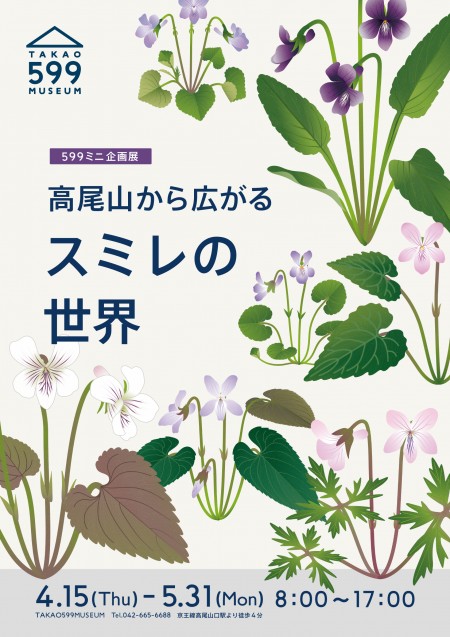
-
Leibnitzia anandria Compositae
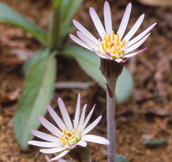
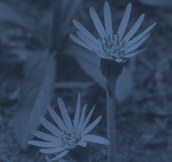 Leibnitzia anandria Compositae
Leibnitzia anandria Compositae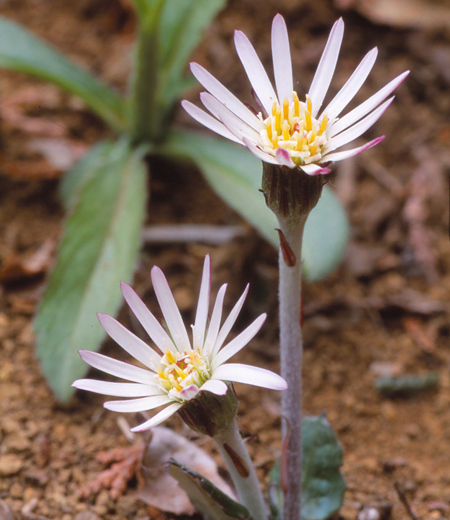 Perennial herbs (grow for several years from their same root system) found in sunny grasslands. Is a unique plant blooms twice, in spring and autumn, and make the entire plant looks different. In spring, are 15 cm in height and bloom small white flowers with light purple on the back of petals, hence it is also called Murasaki-tampopo literally meaning purple dandelions. Leaves also resemble the ones of dandelions and shovel-shaped. In autumn, grow upright stem up to 60 cm long and bloom flowers but it stay as buds that is called cleistogamous flowers (never open and self-pollinating) and covered with fluffy hairs. With many stems upright resemble lances with feather of birds, hence another name Senbon-yari literally meaning a thousand lances.
Perennial herbs (grow for several years from their same root system) found in sunny grasslands. Is a unique plant blooms twice, in spring and autumn, and make the entire plant looks different. In spring, are 15 cm in height and bloom small white flowers with light purple on the back of petals, hence it is also called Murasaki-tampopo literally meaning purple dandelions. Leaves also resemble the ones of dandelions and shovel-shaped. In autumn, grow upright stem up to 60 cm long and bloom flowers but it stay as buds that is called cleistogamous flowers (never open and self-pollinating) and covered with fluffy hairs. With many stems upright resemble lances with feather of birds, hence another name Senbon-yari literally meaning a thousand lances.
●Season Mid April to Late May
●Height Spring 5 to 15 cm, Fall 30 to 60 cm
●Place Trail 1, Trail 5, Mt. Inari, Oku-Takao -
Ixeris dentate Compositae
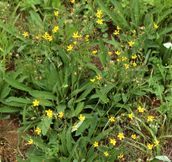
 Ixeris dentate Compositae
Ixeris dentate Compositae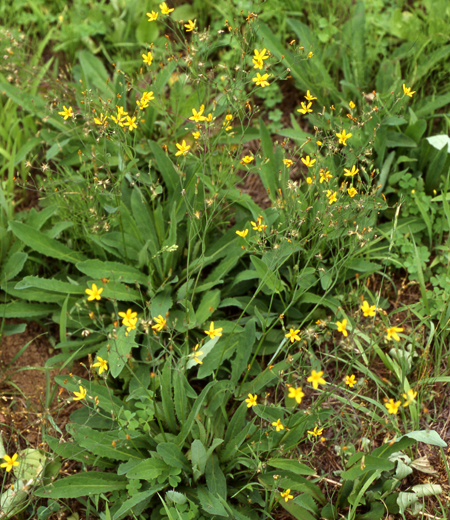 Perennial herbs (grow for several years from their same root system) found in wide varieties of areas including grasslands in mountains or hills. In Mt. Takao, found at bright roadside. When scratching stems or leaves, produce bitter white milk sap, hence the Japanese name Niga-na literally meaning bitter plants (Only have bitter taste and are not poisonous). Stems and leaves are thin and the entire plant looks tall and skinny. The bottom of leaves has toothed margins (edges of leaves are like a teeth of saw). Flowers are 1.5 cm in diameter and have five to seven tongue-shaped yellow petals. Branches divided into many branches and bloom several flowers scattered on these branches. In rare cases, bloom white flowers and called Shiro-nigabana literally meaning white ixeris dentate. The larger plants with seven to eleven petals are called Hana-nigana literally meaning flowers ixeris dentate.
Perennial herbs (grow for several years from their same root system) found in wide varieties of areas including grasslands in mountains or hills. In Mt. Takao, found at bright roadside. When scratching stems or leaves, produce bitter white milk sap, hence the Japanese name Niga-na literally meaning bitter plants (Only have bitter taste and are not poisonous). Stems and leaves are thin and the entire plant looks tall and skinny. The bottom of leaves has toothed margins (edges of leaves are like a teeth of saw). Flowers are 1.5 cm in diameter and have five to seven tongue-shaped yellow petals. Branches divided into many branches and bloom several flowers scattered on these branches. In rare cases, bloom white flowers and called Shiro-nigabana literally meaning white ixeris dentate. The larger plants with seven to eleven petals are called Hana-nigana literally meaning flowers ixeris dentate.
●Season May to July
●Height about 20 to 50 cm
●Place Trail 1, Trail 5, Mt. Inari, Ura-Takao, Oku-Takao -
Cirsium japonicum(Japanese Thistle) Compositae
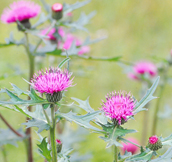
 Cirsium japonicum(Japanese Thistle) Compositae
Cirsium japonicum(Japanese Thistle) Compositae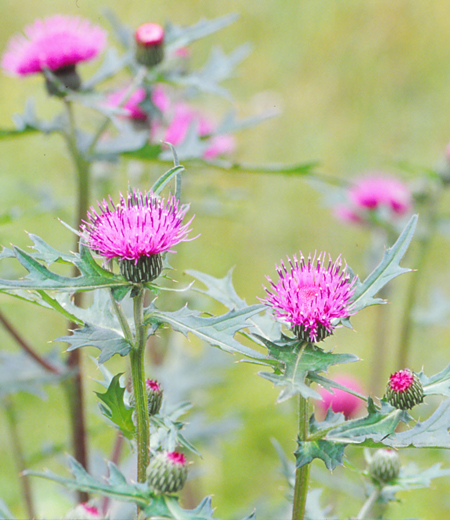 Perennial herbs (grow for several years from their same root system) found in sunny roadside in mountains, riverbanks and grasslands. Bloom red-purple flowers facing upward on upright stems. Flowers are called flower head, many flowers bloom in clusters that looks like one flower from the distance. The size of flowers is 4 to 5 cm in diameter. Buds like parts covering flowers are called involucre and its tips are sticky. Leaves have sharp spines at edges. Many plants are in a cirsium genus and always difficult to identify each plant, however this is the only plant bloom from spring to summer. Azami (Cirsium) come from the word azamuku means to deceive because flowers are beautiful but leaves with spines.
Perennial herbs (grow for several years from their same root system) found in sunny roadside in mountains, riverbanks and grasslands. Bloom red-purple flowers facing upward on upright stems. Flowers are called flower head, many flowers bloom in clusters that looks like one flower from the distance. The size of flowers is 4 to 5 cm in diameter. Buds like parts covering flowers are called involucre and its tips are sticky. Leaves have sharp spines at edges. Many plants are in a cirsium genus and always difficult to identify each plant, however this is the only plant bloom from spring to summer. Azami (Cirsium) come from the word azamuku means to deceive because flowers are beautiful but leaves with spines.
●Season Early May to Late June
●Height about 60 cm to 1 m
●Place Trail 5, Ura-Takao, Oku-Takao -
Gnaphalium affine Compositae
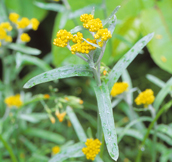
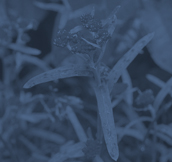 Gnaphalium affine Compositae
Gnaphalium affine Compositae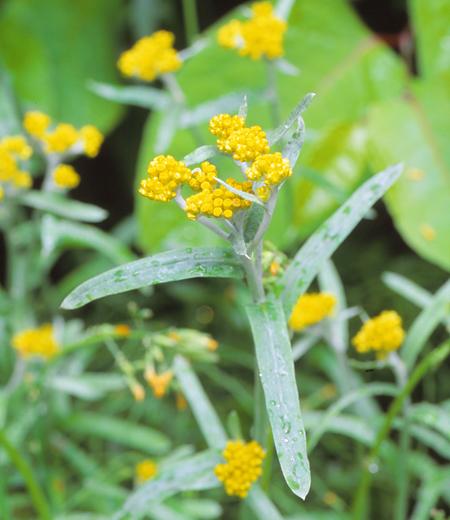 Perennial herbs (grow for several years from their same root system) found at paddy fields, riverbanks and roadside. Bloom from spring to summer but some continue to bloom in autumn. In Mt. Takao, found in sunny forest trails. Is one of seven spring herbs and another name is Gogyo (or Ogyo). A bitter taste of sprout is an essential herb for rice porridge called Nanakusa-gayu (literally meaning seven herbs rice porridge). Was also used for making mochi sweets but after mugwort with wonderful perfume and texture is used instead, people start to use mugwort more often for mochi making. Leaves and stems have white hair densely placed and look silver from the distance. Sprout from the ground full of fallen leaves in early spring is striking. Flowers are flower head consists of many tubular shaped small yellow flowers.
Perennial herbs (grow for several years from their same root system) found at paddy fields, riverbanks and roadside. Bloom from spring to summer but some continue to bloom in autumn. In Mt. Takao, found in sunny forest trails. Is one of seven spring herbs and another name is Gogyo (or Ogyo). A bitter taste of sprout is an essential herb for rice porridge called Nanakusa-gayu (literally meaning seven herbs rice porridge). Was also used for making mochi sweets but after mugwort with wonderful perfume and texture is used instead, people start to use mugwort more often for mochi making. Leaves and stems have white hair densely placed and look silver from the distance. Sprout from the ground full of fallen leaves in early spring is striking. Flowers are flower head consists of many tubular shaped small yellow flowers.
●Season April to June
●Height about 20 to 30 cm
●Place Trail 1 to 6, Mt. Inari, Oku-Takao -
Erigeron philadelphicus(Philadelphia fleabane) Compositae
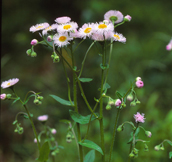
 Erigeron philadelphicus(Philadelphia fleabane) Compositae
Erigeron philadelphicus(Philadelphia fleabane) Compositae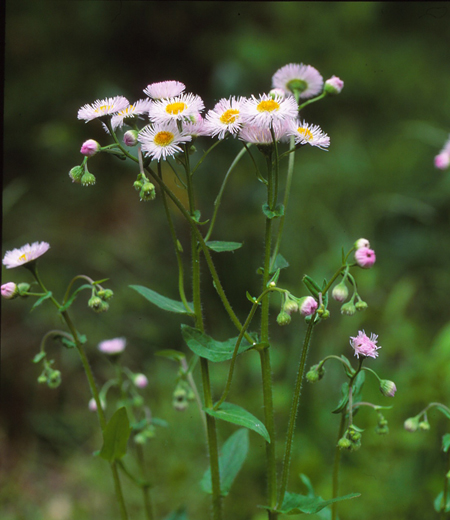 Perennial herbs (grow for several years from their same root system) grow as weeds in spring. Often found them grow in clumps on grasslands. Are originally foreign species native to North America but imported in Taisho era as an ornament plants. Reproductive power is strong and it grows not only in Mt. Takao but also in open spaces and roadside in cities throughout Japan. Flowers are 2 cm in diameter and white or light pink. Buds face the ground but flowers bloom facing upward. Petals are thin and look very delicate. The Japanese name Haru-shion literally meaning aster tataricus in spring was named because purple flowers bloom in spring. Have hair on the entire plants and hollow stems. Leaves are paddle-shaped and the lower parts cover stems.
Perennial herbs (grow for several years from their same root system) grow as weeds in spring. Often found them grow in clumps on grasslands. Are originally foreign species native to North America but imported in Taisho era as an ornament plants. Reproductive power is strong and it grows not only in Mt. Takao but also in open spaces and roadside in cities throughout Japan. Flowers are 2 cm in diameter and white or light pink. Buds face the ground but flowers bloom facing upward. Petals are thin and look very delicate. The Japanese name Haru-shion literally meaning aster tataricus in spring was named because purple flowers bloom in spring. Have hair on the entire plants and hollow stems. Leaves are paddle-shaped and the lower parts cover stems.
●Season April to May
●Height about 30 to 80 cm
●Place Trail 1, Trail 5, Mt. Inari, Ura-Takao, Oku-Takao -
Petasites japonicus(Japanese Butterbur) Compositae
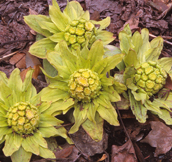
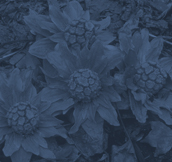 Petasites japonicus(Japanese Butterbur) Compositae
Petasites japonicus(Japanese Butterbur) Compositae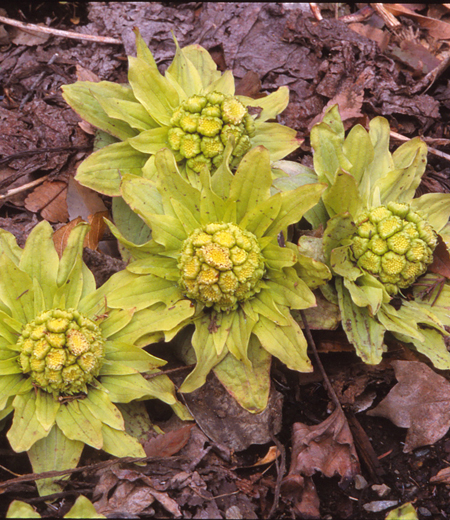 Perennial herbs (grow for several years from their same root system) found on slopes and at forest edges near streams in mountains. In early spring, flower stems (only bloom flowers without leaves) grow before stems grow. This is called Fukino-to, an edible flower bud of Japanese butterbur and a popular wild plants for nice bitter taste. Is widely known for serving tempura or marinated. Flowers are both male and female flowers. Female flowers are white, stems grow after pollinated and seeds with hair resembling the ones of dandelions are flown away by winds. Male flowers are yellow and wither after flowering. Stems grow underground and grow horizontally. After flowering, leaves grow from the underground stems. Leaves are 15 to 30 cm long and petioles are 60 cm long. Leaves are also served boiled or stir-fried.
Perennial herbs (grow for several years from their same root system) found on slopes and at forest edges near streams in mountains. In early spring, flower stems (only bloom flowers without leaves) grow before stems grow. This is called Fukino-to, an edible flower bud of Japanese butterbur and a popular wild plants for nice bitter taste. Is widely known for serving tempura or marinated. Flowers are both male and female flowers. Female flowers are white, stems grow after pollinated and seeds with hair resembling the ones of dandelions are flown away by winds. Male flowers are yellow and wither after flowering. Stems grow underground and grow horizontally. After flowering, leaves grow from the underground stems. Leaves are 15 to 30 cm long and petioles are 60 cm long. Leaves are also served boiled or stir-fried.
●Season March to about May
●Height about 10 to 25 cm
●Place Trail 1, Trail 4 to 6, Jyataki, Ura-Takao, Minami-Takao -
Valeriana flaccidissima Valerianaceae
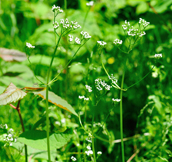
 Valeriana flaccidissima Valerianaceae
Valeriana flaccidissima Valerianaceae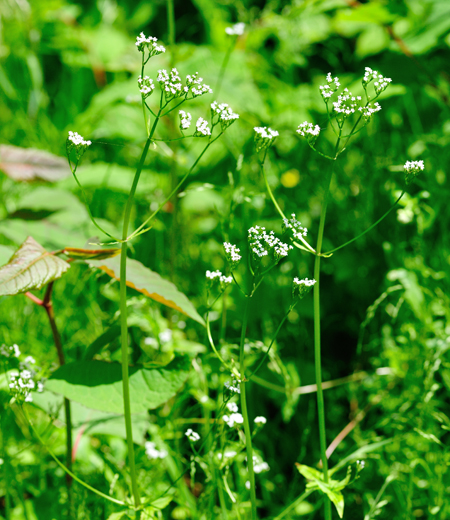 Perennial herbs (grow for several years from their same root system) found in wet tree shades and at streamside in mountains. The Japanese name Tsuru-kanoko-so literally meaning vine fawn plants was named because the shape of flowers from above resemble kanoko-shibori, a cloth dyed in a dapple pattern and vine with sprouts grow after blooming. Soft and thick stem grow upright and bloom small white flowers at the tip. Flowers are light red right after blooming but gradually turn to white. Petals are lobed in five and stamens are not long. Leaves are pinnate with toothed margins (edges of leaves are like a teeth of saw). Leaves in early spring are not pinnate and it looks like other plant. Bear fruits with hair like the seeds of dandelions.
Perennial herbs (grow for several years from their same root system) found in wet tree shades and at streamside in mountains. The Japanese name Tsuru-kanoko-so literally meaning vine fawn plants was named because the shape of flowers from above resemble kanoko-shibori, a cloth dyed in a dapple pattern and vine with sprouts grow after blooming. Soft and thick stem grow upright and bloom small white flowers at the tip. Flowers are light red right after blooming but gradually turn to white. Petals are lobed in five and stamens are not long. Leaves are pinnate with toothed margins (edges of leaves are like a teeth of saw). Leaves in early spring are not pinnate and it looks like other plant. Bear fruits with hair like the seeds of dandelions.
●Season Early April to Mid May
●Height about 20 to 40 cm
●Place Trail 1 to 6, Mt. Inari, Jyataki, Ura-Takao -
Psedopyxis depressa Rubiaceae
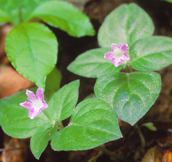
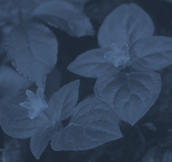 Psedopyxis depressa Rubiaceae
Psedopyxis depressa Rubiaceae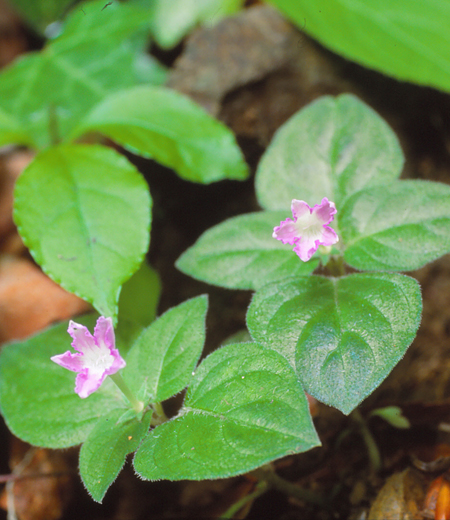 Perennial herbs (grow for several years from their same root system) found in wet and shady areas at roadside near streams. The Japanese name Inamori-so was named because it was first found in Mt. Inamori in Mie prefecture. Also found in Mt. Takao but are not too many. Are not easy to find as they are short plants and do not grow in clumps. The size of leaves is about 3 to 6 cm long and oval-shaped with soft hairs. Leaves are in whorls of 4 to 6 per stem and the light red-purple flower bloom like floating in the air. Flowers are about 2.5cm in diameter and lobed in five with wavy edges which looks delicate. Depending on the place of stamen, have long or short pistils.
Perennial herbs (grow for several years from their same root system) found in wet and shady areas at roadside near streams. The Japanese name Inamori-so was named because it was first found in Mt. Inamori in Mie prefecture. Also found in Mt. Takao but are not too many. Are not easy to find as they are short plants and do not grow in clumps. The size of leaves is about 3 to 6 cm long and oval-shaped with soft hairs. Leaves are in whorls of 4 to 6 per stem and the light red-purple flower bloom like floating in the air. Flowers are about 2.5cm in diameter and lobed in five with wavy edges which looks delicate. Depending on the place of stamen, have long or short pistils.
●Season Early May to Late June
●Height about 5 to 10 cm
●Place Trail 1 to 2, Trail 6, Mt. Inari -
Veronica miqueliana Scrophulariaceae
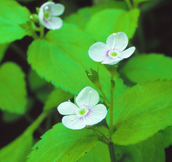
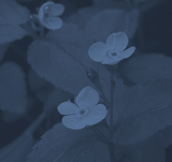 Veronica miqueliana Scrophulariaceae
Veronica miqueliana Scrophulariaceae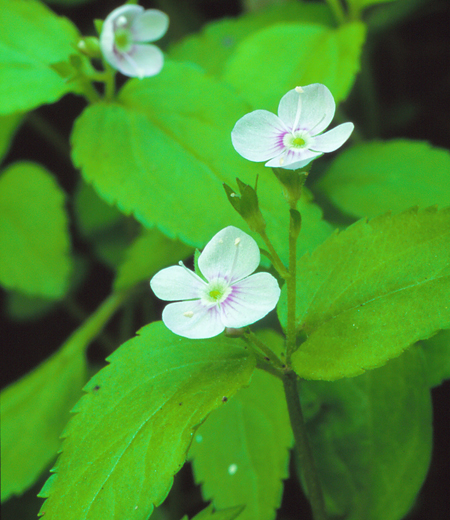 Perennial herbs on swampy forest ground near streams. Bloom in late spring after trees shoot out buds. The fan-shaped calyx after flowering resemble the hoe-shaped helmet crest (Kuwagata), hence the Japanese name Kuwagata-so. Color of flowers is light red-purple and bloom one to five from the base of leaves on upper parts of stems. The size of flower is 1 cm in diameter and has some purple lines radiating from the center of petals. The dish-shaped corolla is parted, making flowers have four petals. Leaves are opposite with two leaves. The shape of leaves is egg-shaped with pointed tip and roughly toothed margins. The ones towards tips of stems are large and about 3 to 5 cm. Stems and leaves have short hairs.
Perennial herbs on swampy forest ground near streams. Bloom in late spring after trees shoot out buds. The fan-shaped calyx after flowering resemble the hoe-shaped helmet crest (Kuwagata), hence the Japanese name Kuwagata-so. Color of flowers is light red-purple and bloom one to five from the base of leaves on upper parts of stems. The size of flower is 1 cm in diameter and has some purple lines radiating from the center of petals. The dish-shaped corolla is parted, making flowers have four petals. Leaves are opposite with two leaves. The shape of leaves is egg-shaped with pointed tip and roughly toothed margins. The ones towards tips of stems are large and about 3 to 5 cm. Stems and leaves have short hairs.
●Season Early May to about Early June
●Height about 10 to 20 cm
●Place Trial 6, Ura-Takao
Insects
Mt. Takao is considered one of the three major habitat of insects along with Minoo (Osaka prefecture) and Kibune (Kyoto prefecture) and it has long been loved by researchers of insects because of number of species and the easy access from the Metropolitan area. There are many insects first found in Mt. Takao and named after "Takao" such as Takao Shachihoko (Hiradonta takaonis Matsumura) and Takao medaka kamikiri (Stenhomalus takaosanus).
-
(日本語) チョウが舞う高尾山

 (日本語) チョウが舞う高尾山
(日本語) チョウが舞う高尾山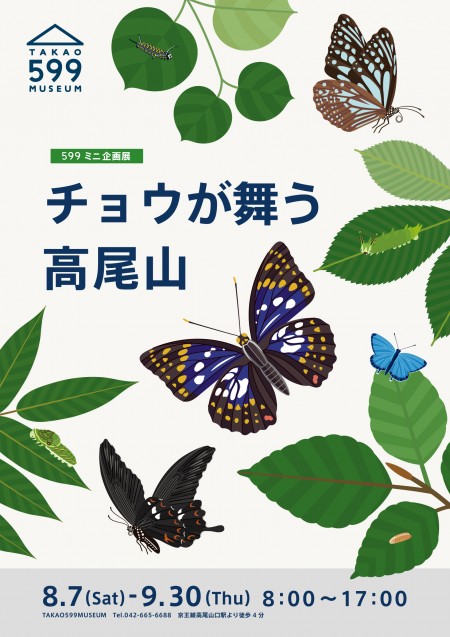
-
Papilio xuthus(Asian Swallowtail) Papilionidae
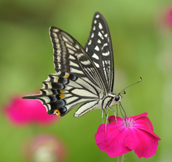
 Papilio xuthus(Asian Swallowtail) Papilionidae
Papilio xuthus(Asian Swallowtail) Papilionidae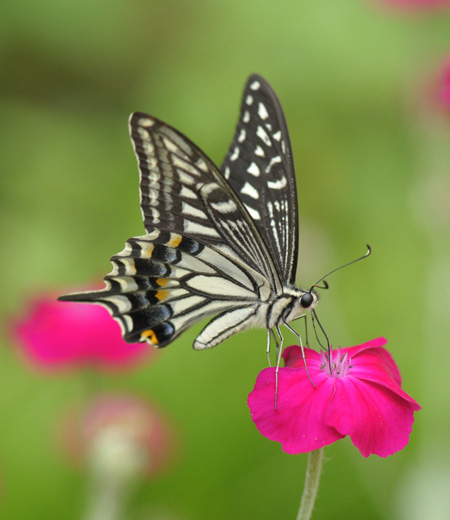 Main Region: Hokkaido, Honshu, Shikoku, Kyushu, Okinawa, Sado Island and Yaku Island.
Main Region: Hokkaido, Honshu, Shikoku, Kyushu, Okinawa, Sado Island and Yaku Island.
Well-known butterfly and often seen in residential areas in cities as well as suburban areas because caterpillars feed on plants in rutaceae family which often planted at gardens or hedges.
This species is so-called swallowtails.
Fly to sunny trees and grasslands and feed on nectar of ericaceae, cirsium and cayratia japonica.
Color of wings is less yellowish yellow-white to white than papilio machaon.
Black lines along wing veins create complicated patterns.
Have blue and red patterns at the bottom of hind wings.
The difference between male and female is the tip of abdomen, male is sharp-shaped because of the reproductive organs and female is more round-shaped.
●Wingspan (length when fore wings are open) about 65 to 90 mm
●Adult Flight Season April to about October -
Papilio machaon (Old World Swallowtail) Papilionidae
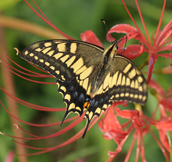
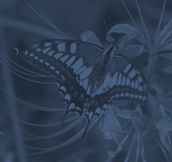 Papilio machaon (Old World Swallowtail) Papilionidae
Papilio machaon (Old World Swallowtail) Papilionidae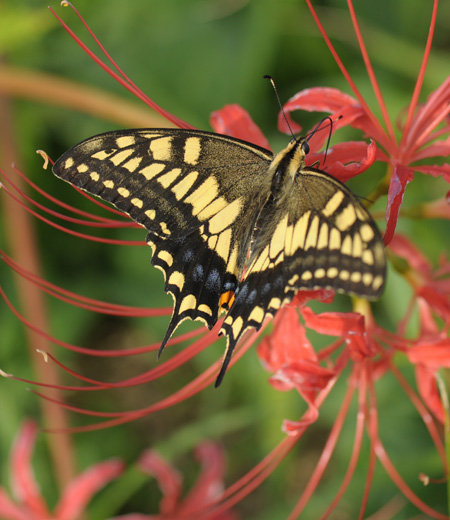 Main Region: Hokkaido, Honshu, Shikoku, Kyushu, Sado Island, Goto Islands and Yaku Island.
Main Region: Hokkaido, Honshu, Shikoku, Kyushu, Sado Island, Goto Islands and Yaku Island.
Prefer sunny grasslands and paddy fields from flatlands to mountains.
Often seen at parks and residential areas in cities.
Adults are also found from flatlands to high lands of 3000 meters elevations, thus living area varies to different elevations.
Fly to green grasslands during the daytime and feed on nectar of ericaceae and cirsium.
Caterpillars feed on leaves of plants in apiaceae family including water dropwort javanica and parsleys.
Body is similar to swallowtail but can be distinguished by the wing color, which more strong yellow as the Japanese name Ki-ageha literally meaning yellow swallowtail states.
And at the base of wings are black without any patterns.
Male holds territory at high elevations, and is often seen around mountain peak.
●Wingspan about 70 to 90 mm
●Adult Flight Season April to about September -
Papilio protenor (Spangle) Papilionidae
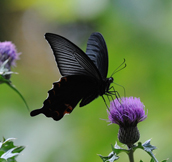
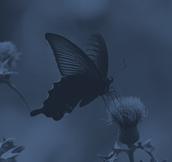 Papilio protenor (Spangle) Papilionidae
Papilio protenor (Spangle) Papilionidae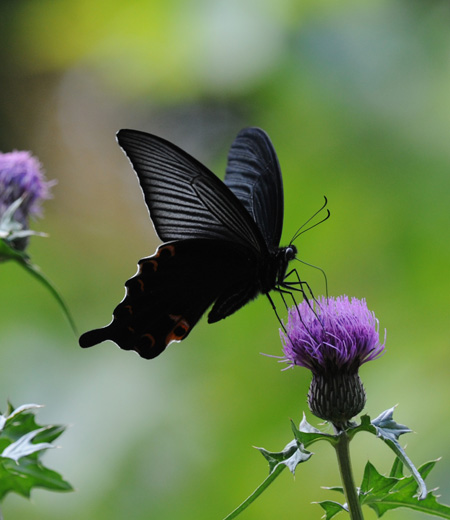 Main Region: Honshu (South of southern Tohoku area), Shikoku, Kyushu, Okinawa and Yaeyama Islands.
Main Region: Honshu (South of southern Tohoku area), Shikoku, Kyushu, Okinawa and Yaeyama Islands.
Prefer shadowy areas and found in woody forests, sometimes seen at parks and residential areas in cities.
In Mt. Takao, often found at mountain trails.
Body color is mat black and tails at the lower tips of hind wings are smaller than other species in papilionidae.
Do not have strong characteristics so it is easy to identify.
On the back of hind wings, male has red spots only on the back and female has them on both sides.
Fly to shady area avoiding sun and feed on nectar of plants in ericaceae family.
Caterpillars feed on leaves of plants in rutaceae family.
●Wingspan about 80 to 120 mm
●Adult Flight Season April to about October -
Papilio macilentus (The Long Tail Spangle) Papilionidae
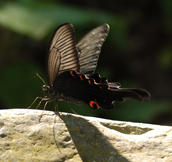
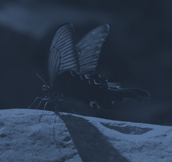 Papilio macilentus (The Long Tail Spangle) Papilionidae
Papilio macilentus (The Long Tail Spangle) Papilionidae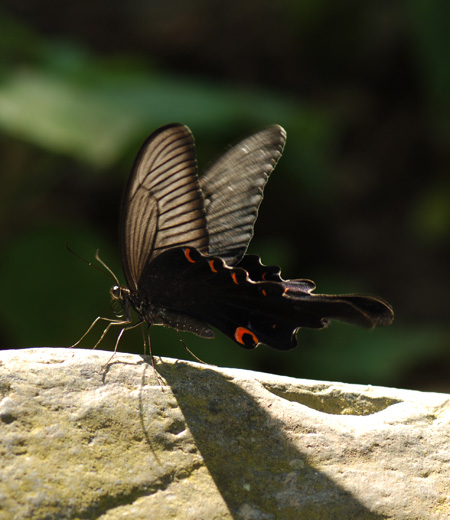 Main Region: Hokkaido, Honshu, Shikoku, Kyushu, Okushiri Island, Sado Island and Shodo Island.
Main Region: Hokkaido, Honshu, Shikoku, Kyushu, Okushiri Island, Sado Island and Shodo Island.
Found in woods on hills or at streamsides in mountains.
Wings are shiny black and have crescent moon-shaped red patterns on edges of hind wings.
These patterns on female are more distinct.
Only male have white front edges of hind wings but this is often covered by fore wings.
Similar to papilio protenor but this species have long tails as Japanese name Onaga-ageha literally meaning long tail swallowtail states.
Fly around streamsides in mountains and feed on nectar from azalea and lilium medeoloides.
Caterpillars feed on leaves of orixa japonica and Japanese pepper.
Only male suck waters at paddles and swamps sometimes do in groups.
●Wingspan about 90 to 110 mm
●Adult Flight Season April to about September -
Papilio bianor (Chinese Peacock) Papilionidae
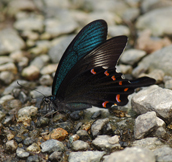
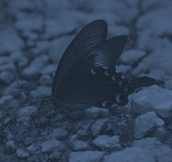 Papilio bianor (Chinese Peacock) Papilionidae
Papilio bianor (Chinese Peacock) Papilionidae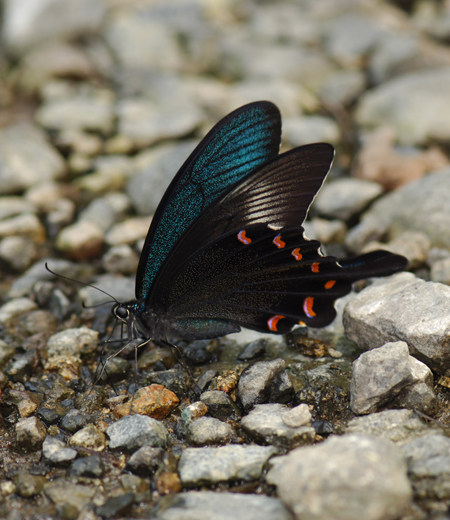 Main Region: Hokkaido, Honshu, Shikoku, Kyushu and other isolated islands including Goto Islands.
Main Region: Hokkaido, Honshu, Shikoku, Kyushu and other isolated islands including Goto Islands.
Found in forests from flatlands to mountains.
Wing color is black and covered by blue-green scales and the colors and brightness differ by viewing angles and are very beautiful.
The back of wings is black with red spots on hind wings.
Male has mat and hairy part on fore wings that are to distinguish male from female.
Is active during daytime and fly fast and feed on nectar of plants in ericaceae family and moss phlox.
Caterpillars feed on leaves of orixa japonica and Japanese pepper.
Only male suck fresh water on mountain trails in Mt. Takao.
Male in papilionidae family fly on the same route regularly, which is called flyway.
●Wingspan about 80 to 110 mm
●Adult Flight Season April to about September -
Papilio maackii(Maackii Peacock) Papilionidae
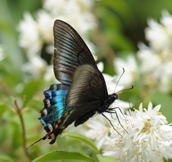
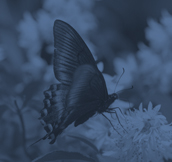 Papilio maackii(Maackii Peacock) Papilionidae
Papilio maackii(Maackii Peacock) Papilionidae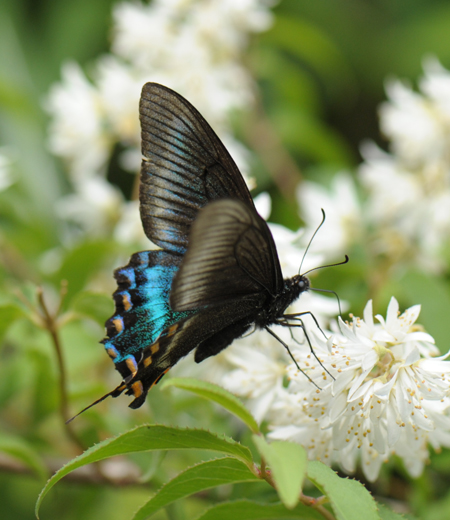 Main Region: Hokkaido, Honshu, Shikoku, Kyushu, Okinawa, Sado Island, Tanega Island and Yaku Island.
Main Region: Hokkaido, Honshu, Shikoku, Kyushu, Okinawa, Sado Island, Tanega Island and Yaku Island.
Found in forests from low elevations to mountains, also in woods along coastline.
Is not too appealing but very beautiful with black wings covered by blue scales creating bright green or deep blue by different viewing angles.
Some says that this species is the most beautiful butterfly representing Japan.
Bright belt-like colors on the back of fore and hind wings are to distinguish them from similar papilio bianor but some species have less distinct patterns.
Male fly to various kinds of places, even at mountain peaks and adults feed on nectar of plants in ericaceae family.
Caterpillars feed on leaves of Japanese prickly-ash.
●Wingspan about 90 to 120 mm
●Adult Flight Season May to about September -
Byasa alcinous (Chinese Windmill) Papilionidae
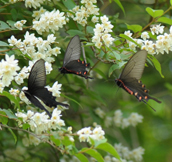
 Byasa alcinous (Chinese Windmill) Papilionidae
Byasa alcinous (Chinese Windmill) Papilionidae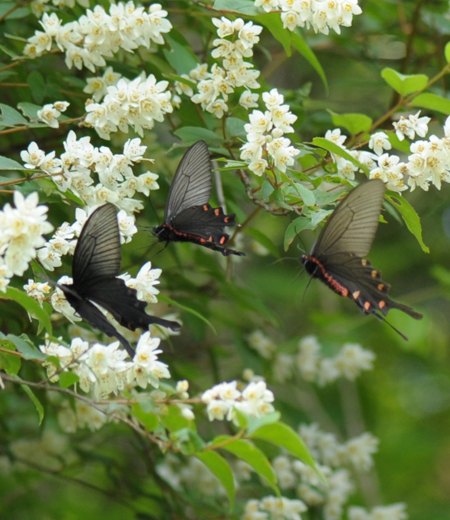 Main Region: Honshu, Shikoku, Kyushu, Okinawa, Goto Islands, Yaku Island and Amami Islands.
Main Region: Honshu, Shikoku, Kyushu, Okinawa, Goto Islands, Yaku Island and Amami Islands.
Found in various places from bright areas of riverbeds and grassland in flatlands to woody areas and forests from flatlands to mountains.
Wing colors differ by sex, male is mat smoky black and female is yellow-gray to dark-gray with distinct black wing veins.
Both male and female have crescent moon-shaped red patterns on the back of hind wings.
Caterpillars feed on aristolochia debilis that are poisonous and the body of caterpillars with red patterns display that they are also poisonous.
Is active during daytime and feed on nectar from plants in ericaceae family, deutzia crenata and in Cirsium family.
Japanese name Jyako-ageha literally meaning musk swallowtail was named because male adults are musk-scented.
●Wingspan about 75 to 100 mm
●Adult Flight Season May to about September -
Papilio helenus (Red Helen) Papilionidae
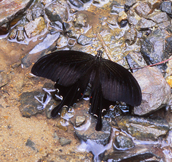
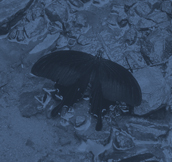 Papilio helenus (Red Helen) Papilionidae
Papilio helenus (Red Helen) Papilionidae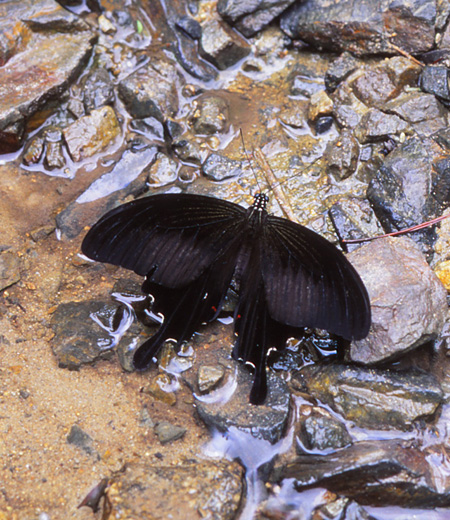 Main Region: Honshu (South of Miyagi prefecture), Shikoku, Kyushu, Okinawa, Goto Islands, Yaku Island and Tanega Island.
Main Region: Honshu (South of Miyagi prefecture), Shikoku, Kyushu, Okinawa, Goto Islands, Yaku Island and Tanega Island.
Is the largest butterfly in Japan.
Found in woody and shady areas from flatlands to mountains.
Have large yellow-white pattern on hind wings and Japanese name Monki-ageha literally meaning yellow pattern swallowtail comes from this color and patterns.
Also have red spots at edges of hind wings and female ones are more distinct.
Is active during daytime, fly in woods and feed on nectar of deutzia crenata, clerodendrum trichotomum and red spider lily.
Caterpillars feed on leaves of Japanese Prickly-ash.
Male holds own flyway at streamsides.
Female body is larger than male.
Wingspan about 110 to 140 mm
Adult Flight Season May to about September -
Graphium sarpedon (Common Bluebottle) Papilionidae
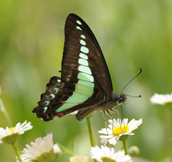
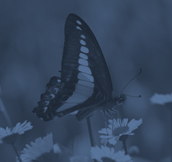 Graphium sarpedon (Common Bluebottle) Papilionidae
Graphium sarpedon (Common Bluebottle) Papilionidae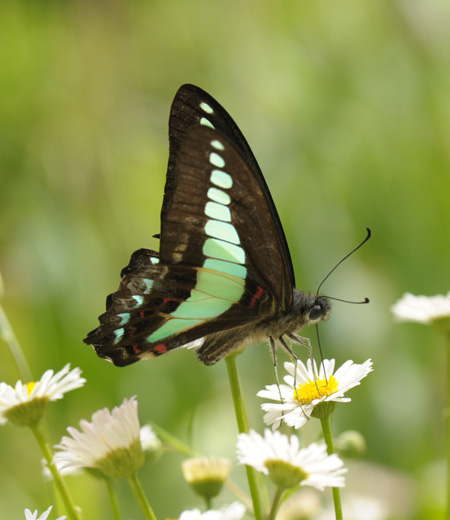 Main Region: Warm climate areas of Honshu (South of southern Tohoku region), Shikoku, Kyushu and Okinawa.
Main Region: Warm climate areas of Honshu (South of southern Tohoku region), Shikoku, Kyushu and Okinawa.
Found in forests from flatlands to low elevations.
Have very distinct light blue belt-like pattern on black wings with red or orange spots on back of wings that are not too appealing while flying.
Found at parks in cities because caterpillars feed on leaves of camphor laurel often planted as street trees.
Fly fast during daytime and feed on nectar of annual fleabane and cayratia japonica.
Male suck water in summer and often seen in groups at watersides.
Wingspan about 50 to 60 mm
Adult Flight Season May to about October
Animals
The natural forest widely remain in Mt. Takao which is different from the man-made forests in nearby area. The south face is warm temperate forest with trees like oak trees and the north face is temperate forests with trees like Fagus crenata. About 30 kinds of animals including mammals such as flying squirrel and squirrel, reptile, amphibia and fish inhabits that prefers Mt. Takao's varieties of species of preys and forests. One way to enjoy exploring Mt. Takao is to find these animal's nests.
-
(日本語) 高尾山に暮らすタヌキ展

 (日本語) 高尾山に暮らすタヌキ展
(日本語) 高尾山に暮らすタヌキ展 2021年2月1日~2021年3月31日「高尾山に暮らすタヌキ展」
2021年2月1日~2021年3月31日「高尾山に暮らすタヌキ展」
人里近くに生息する哺乳類であるタヌキ。タヌキが高尾の森で、どんなものを食べ、どのように他の生きもの達と関わり合っているのか。高尾山での暮らしを通してその生態に迫ります。 -
Macaca fuscata (Japanese Macaque) Cercopithecidae
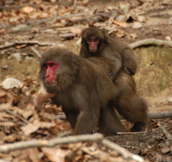
 Macaca fuscata (Japanese Macaque) Cercopithecidae
Macaca fuscata (Japanese Macaque) Cercopithecidae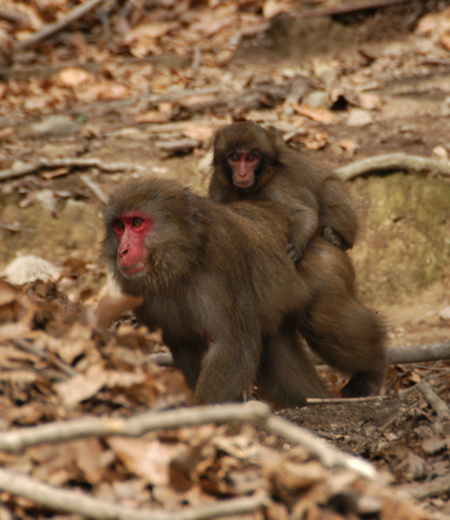 Main region: Honshu, Shikoku and Kyushu. The ones live in Shimokita peninsula in Aomori prefectures are widely known as the World’s northernmost monkeys (Hokugen-no-saru in Japanese). Found in forests in mountains. In Mt. Takao, there are wild species and sometimes found them in groups at mountain trails. Red face and red bottom is very distinctive. Normally live in large groups called troop consists of several males and hundreds of female and children. Thus, there is a possibility of finding many monkeys when encountering just one monkey. Are omnivores and mainly feed on vegetables. Feed on leaves and sprouts of plants, fruits and insects and even barks of trees in winter when there are limited foods. Have cheek pouches, where food is stuffed temporarily.
Main region: Honshu, Shikoku and Kyushu. The ones live in Shimokita peninsula in Aomori prefectures are widely known as the World’s northernmost monkeys (Hokugen-no-saru in Japanese). Found in forests in mountains. In Mt. Takao, there are wild species and sometimes found them in groups at mountain trails. Red face and red bottom is very distinctive. Normally live in large groups called troop consists of several males and hundreds of female and children. Thus, there is a possibility of finding many monkeys when encountering just one monkey. Are omnivores and mainly feed on vegetables. Feed on leaves and sprouts of plants, fruits and insects and even barks of trees in winter when there are limited foods. Have cheek pouches, where food is stuffed temporarily.
●Body Length about 47 to 70 cm
●Season All year -
Sus scrofa leucomystax (Japanese Wild Boar) Suidae
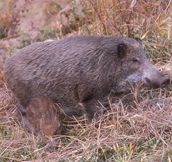
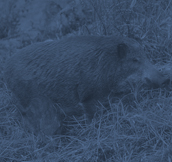 Sus scrofa leucomystax (Japanese Wild Boar) Suidae
Sus scrofa leucomystax (Japanese Wild Boar) Suidae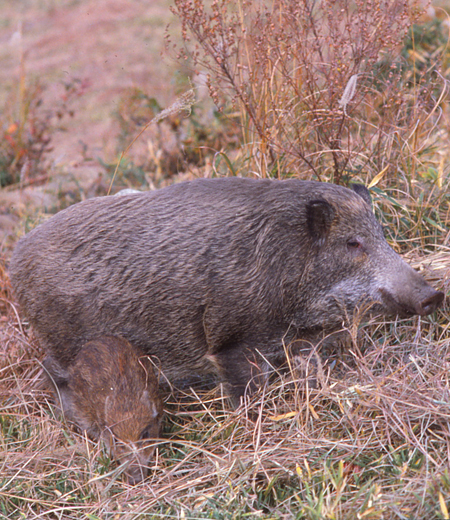 Main region: Honshu (West of Kanto area), Shikoku and Kyushu. Found in woodlands in satoyama (satoyama is where residential area and woodlands coexists in rural area) and forests in mountains. The color of hair is gray-brown to light black or brown. The wild boar piglets have stripe patterns and often called as “Uribo (wild boar piglet)”. Are active at night. Dig up the ground with snouts and feed on roots of plants, insects and earthworms. Their sense of smell is well developed which enable them to look for potatoes in soils with snout. Have unique habit called Nuta (nota)-uchi literally meaning to wallow in muds. This is to scrape off parasites by bathing in the muds or swampy areas they created. In Mt. Takao, sometimes these swampy areas where wild boars wallowed could be found near mountain trails.
Main region: Honshu (West of Kanto area), Shikoku and Kyushu. Found in woodlands in satoyama (satoyama is where residential area and woodlands coexists in rural area) and forests in mountains. The color of hair is gray-brown to light black or brown. The wild boar piglets have stripe patterns and often called as “Uribo (wild boar piglet)”. Are active at night. Dig up the ground with snouts and feed on roots of plants, insects and earthworms. Their sense of smell is well developed which enable them to look for potatoes in soils with snout. Have unique habit called Nuta (nota)-uchi literally meaning to wallow in muds. This is to scrape off parasites by bathing in the muds or swampy areas they created. In Mt. Takao, sometimes these swampy areas where wild boars wallowed could be found near mountain trails.
●Body Length about 140 cm
●Season All year -
Meles anakuma (Japanese Badger) Mustelidae
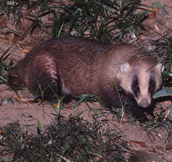
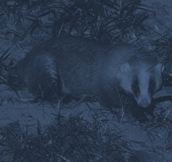 Meles anakuma (Japanese Badger) Mustelidae
Meles anakuma (Japanese Badger) Mustelidae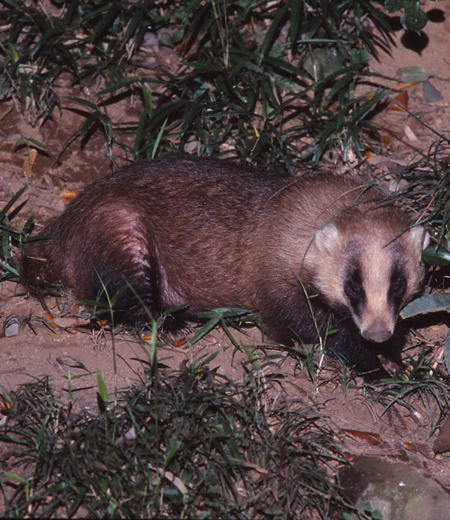
Main region: Honshu, Shikoku and Kyushu. Found in forests from low elevations to mountains. The other name is Mujina in Japanese but often mixed up with raccoon dog as they are also called as Mujina in some places in Japan. Both badger and raccoon dog are very similar in appearance and habit, however raccoon dog is in canidae family that is not a closely related species. The Japanese name is Nihon-anaguma has the word bear (guma) but they are not in the same family with bears. Are good at digging holes as Anaguma literally meaning hall digging bear states. Create 10 to 20 meters long tunnel in underground and lairs by using sharp nails. Rest in lairs during daytime and become active at night. Walk around mountains and feed on acorns, fruits, earthworms, insects, frogs and snails.
●Body Length about 44 to 68 cm
●Season April to November -
Sciurus lis (Japanese Squirrel) Japanese Dwarf Flying Squirrel
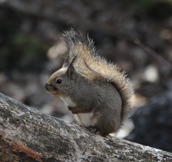
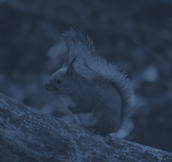 Sciurus lis (Japanese Squirrel) Japanese Dwarf Flying Squirrel
Sciurus lis (Japanese Squirrel) Japanese Dwarf Flying Squirrel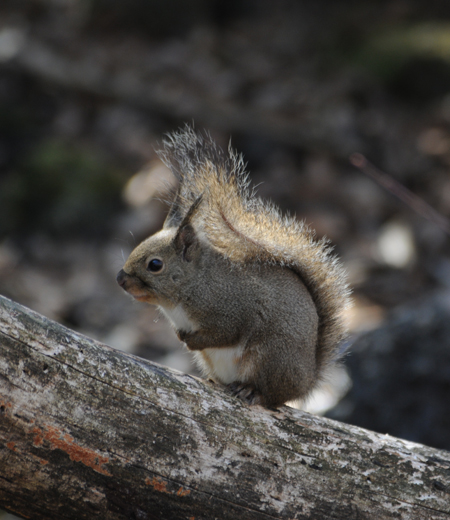 Main region: Honshu, Shikoku, and Kyushu. Rarely seen in Kyushu and Chugoku region due to deteriorated habitat. Found in forests in low elevations. Live mostly on trees but often come down to the ground. Create spherical shaped dreys with small branches and moss at spaces between branches. Are active in early morning and late afternoon but sometimes found at mountain trails. Feed on nuts and buds of trees and store a number of acorns in soils for the foods during winter. Have distinct long tails and look very cute when holding acorns and walnuts to eat. Sometimes, they jump more than 10 meters and move from branches to branches.
Main region: Honshu, Shikoku, and Kyushu. Rarely seen in Kyushu and Chugoku region due to deteriorated habitat. Found in forests in low elevations. Live mostly on trees but often come down to the ground. Create spherical shaped dreys with small branches and moss at spaces between branches. Are active in early morning and late afternoon but sometimes found at mountain trails. Feed on nuts and buds of trees and store a number of acorns in soils for the foods during winter. Have distinct long tails and look very cute when holding acorns and walnuts to eat. Sometimes, they jump more than 10 meters and move from branches to branches.
●Body Length about 20 cm
●Season all year round -
Petaurista leucogenys (Japanese Giant Flying Squirrel) Japanese Dwarf Flying Squirrel
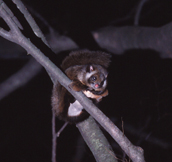
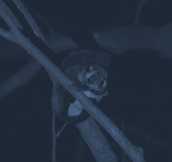 Petaurista leucogenys (Japanese Giant Flying Squirrel) Japanese Dwarf Flying Squirrel
Petaurista leucogenys (Japanese Giant Flying Squirrel) Japanese Dwarf Flying Squirrel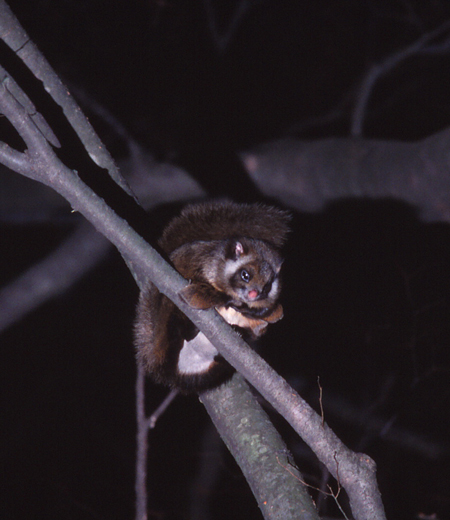 Main region: Honshu, Shikoku and some part of Kyushu. Found in forests from flatlands to mountains. Are well known as gliding mammals. Glide like a glider from a tree to a tree by stretching wings covering their body and feed on leaves, buds, flowers and seeds of trees. With well-developed gliding ability, glide over 100 meters. Live mostly on trees and rest in a nest created in hollows and holes of big trees during daytime. Become active after sunset and hunt for prey. In Mt. Takao, often found around Yakuoin and a tour with guide is organized.
Main region: Honshu, Shikoku and some part of Kyushu. Found in forests from flatlands to mountains. Are well known as gliding mammals. Glide like a glider from a tree to a tree by stretching wings covering their body and feed on leaves, buds, flowers and seeds of trees. With well-developed gliding ability, glide over 100 meters. Live mostly on trees and rest in a nest created in hollows and holes of big trees during daytime. Become active after sunset and hunt for prey. In Mt. Takao, often found around Yakuoin and a tour with guide is organized.
●Body Length about 34 to 50 cm
●Season All year(未翻訳)鳴き声を聞く
-
Pteromys momonga (Japanese Dwarf Flying Squirrel) Japanese Dwarf Flying Squirrel
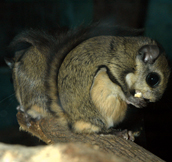
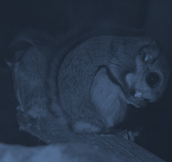 Pteromys momonga (Japanese Dwarf Flying Squirrel) Japanese Dwarf Flying Squirrel
Pteromys momonga (Japanese Dwarf Flying Squirrel) Japanese Dwarf Flying Squirrel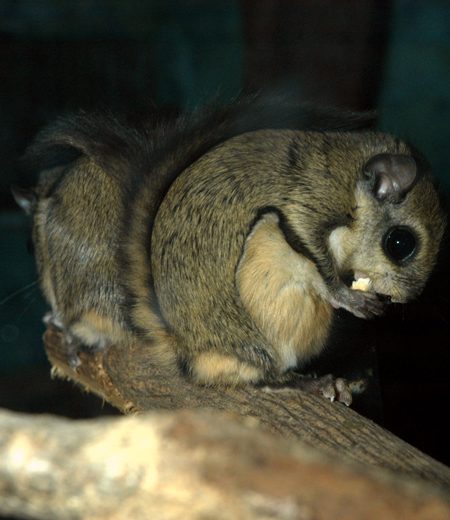 Main region: Honshu, Shikoku and Kyushu. Found in forests in mountains. Have distinct big round eyes and glide by stretching wings like giant flying squirrels. Flight distance is normally 20 to 30 meters but sometimes glide over 100 meters and their flight ability is like giant flying squirrels. Live mostly on trees and become active at night and feed on leaves, buds, fruits, seeds and barks of trees by gliding from trees to trees. The body size is a lot smaller than giant flying squirrels and they are twice as large in body length and 10 times heavier in weight.
Main region: Honshu, Shikoku and Kyushu. Found in forests in mountains. Have distinct big round eyes and glide by stretching wings like giant flying squirrels. Flight distance is normally 20 to 30 meters but sometimes glide over 100 meters and their flight ability is like giant flying squirrels. Live mostly on trees and become active at night and feed on leaves, buds, fruits, seeds and barks of trees by gliding from trees to trees. The body size is a lot smaller than giant flying squirrels and they are twice as large in body length and 10 times heavier in weight.
●Body Length about 14 to 20 cm
●Season All year -
Apodemus speciosus (Large Japanese Field Mouse) Muridae
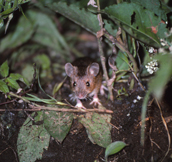
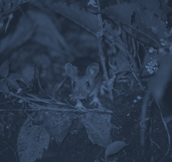 Apodemus speciosus (Large Japanese Field Mouse) Muridae
Apodemus speciosus (Large Japanese Field Mouse) Muridae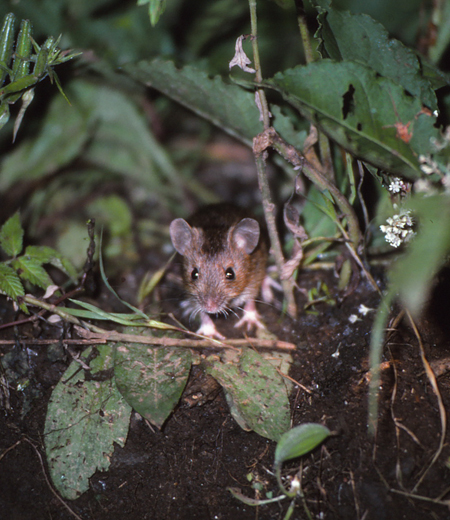 Main region: Hokkaido to Kyushu. This species and small Japanese field mouse are fields mouse native to Japan found in mountains throughout Japan. Small Japanese field mouse live on trees but this species live on ground and do not climb trees. Dig tunnels and nest underground. Feed on fallen seeds, rhizomes and small insects. Tends to store dozens of times the volumes of nuts and seeds including acorns typically consume. The body hair is red-brown as the Japanese name Aka-nezumi literally meaning red-colored rat state. Have distinct big round eyes but are rarely seen during the day because they are mostly active at night. Hind legs are well developed and could walk a couple of kilometers.
Main region: Hokkaido to Kyushu. This species and small Japanese field mouse are fields mouse native to Japan found in mountains throughout Japan. Small Japanese field mouse live on trees but this species live on ground and do not climb trees. Dig tunnels and nest underground. Feed on fallen seeds, rhizomes and small insects. Tends to store dozens of times the volumes of nuts and seeds including acorns typically consume. The body hair is red-brown as the Japanese name Aka-nezumi literally meaning red-colored rat state. Have distinct big round eyes but are rarely seen during the day because they are mostly active at night. Hind legs are well developed and could walk a couple of kilometers.
●Body Length about 8 to 14 cm
●Season All year -
Apondemus argenteus (Small Japanese Field Mouse) Muridae
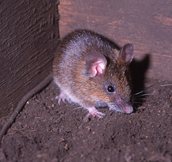
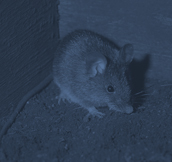 Apondemus argenteus (Small Japanese Field Mouse) Muridae
Apondemus argenteus (Small Japanese Field Mouse) Muridae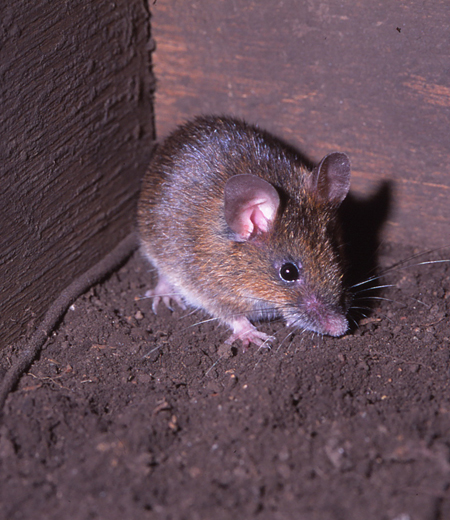 Main region: Throughout Japan including Hokkaido, Honshu, Shikoku, Kyushu, Sado Island, Miyake Island and Yaku Island. Field mouse native to Japan found in forests from low to high elevations. Very similar to large Japanese field mouse but the body size is a lot smaller and tail is longer than the length from the head to the ramp. The large Japanese field mouse live on ground but this species live mostly on trees as their body weight is lighter and have flexible tails and thin leg fingers. Balance the body with long tails and move fast even on vines and thin branches. Are semi-arboreal and live up to 10 meters high and sometimes create nests on trees. Feed on acorns, seeds and insects.
Main region: Throughout Japan including Hokkaido, Honshu, Shikoku, Kyushu, Sado Island, Miyake Island and Yaku Island. Field mouse native to Japan found in forests from low to high elevations. Very similar to large Japanese field mouse but the body size is a lot smaller and tail is longer than the length from the head to the ramp. The large Japanese field mouse live on ground but this species live mostly on trees as their body weight is lighter and have flexible tails and thin leg fingers. Balance the body with long tails and move fast even on vines and thin branches. Are semi-arboreal and live up to 10 meters high and sometimes create nests on trees. Feed on acorns, seeds and insects.
●Body Length about 6 to 10 cm
●Season All year -
Eothenomys smithii Muridae
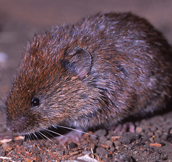
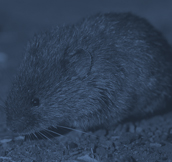 Eothenomys smithii Muridae
Eothenomys smithii Muridae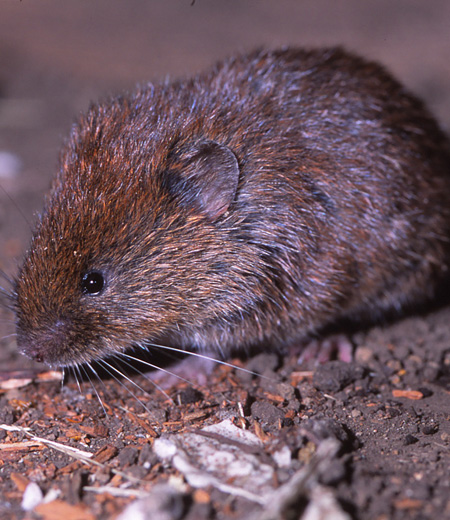 Main Region: South of Niigata and Fukushima prefecture in Honshu, and Kuyshu, Shikoku and Oki-Togo Island of Oki Islands.
Main Region: South of Niigata and Fukushima prefecture in Honshu, and Kuyshu, Shikoku and Oki-Togo Island of Oki Islands.
Found in massif of low to high mountains. IN Mt. Takao, it is found at Mt. Takao station of cable car and forests around 350 meters above sea level on Trail 1.
The color of hair is red-brown to yellow-brown on the back and light orange to orange on the stomach. Feed on grass grow in rocky area and nuts. Having small eyes and ears with a relatively short tail are suitable for living underground. Live both on and under the ground by digging shallow tunnels in forests or create a nest in a space between rocks with fallen leaves.
Body Length: about 7 to 11 cm
Season: All year
Birds
One of great attraction of Mt. Takao is to be able to observe all kinds of birds. Its number is almost 150 kinds which is one third of the species confirmed in all over Japan. Mt. Takao is the paradise for birds and one of the best place for bird watching. Various kinds of birds and its lifestyle could be observed including summer birds come in spring time, winter birds come from the higher altitude and hearing beautiful bird songs during breeding season.
-
(日本語) 高尾山がつなぐ野鳥と木の実

 (日本語) 高尾山がつなぐ野鳥と木の実
(日本語) 高尾山がつなぐ野鳥と木の実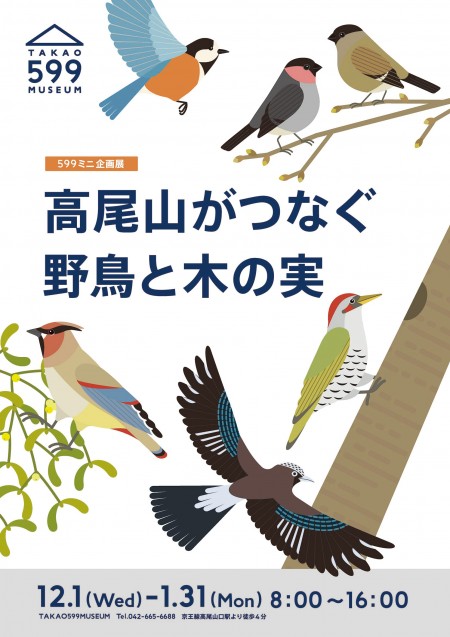 2021年12月1日~2022年1月31日「高尾山がつなぐ野鳥と木の実」
2021年12月1日~2022年1月31日「高尾山がつなぐ野鳥と木の実」
高尾山で見られる野鳥たちとカラフルな木の実をご紹介します。秋から冬にかけて実る木の実は、野鳥たちのごちそう!登る前に立ち寄って、野鳥と出会うきっかけを探してみませんか? -
Phasianus soemmerringii (Copper Pheasant) Phasianidae
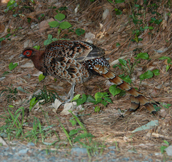
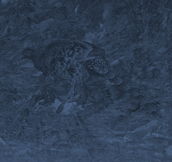 Phasianus soemmerringii (Copper Pheasant) Phasianidae
Phasianus soemmerringii (Copper Pheasant) Phasianidae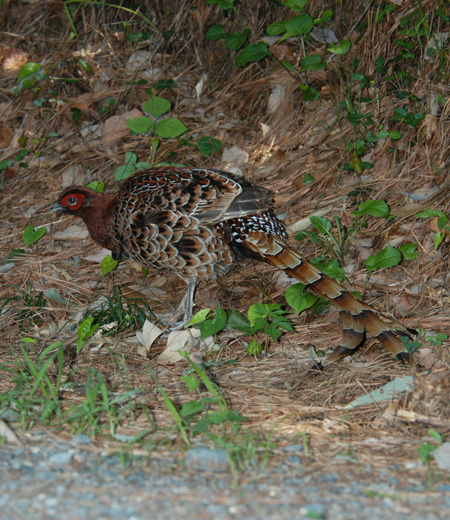 This is in the phasianidae family only distributed in Japan. This species is larger than the Japanese pheasant and the tail of males is longer than the head and body length. Whereas the Japanese pheasant prefers sunny areas, this species prefers shady forests. The body color is brownish for both males and females that blends in the background and is not easy to find them. The voice is not too loud “coo coo coo coo”. They walk between trees and hunt for insects, earthworms, seeds of plants and trees and buds of trees. The breeding season is from April to June, males become more active and do drumming (make sound by fluttering wings and make “doo doo doo doo” sounds) to announce their territory. They build a nest in hollows of a tree by collecting fallen leaves and tree barks and lay seven to ten eggs in a season.
This is in the phasianidae family only distributed in Japan. This species is larger than the Japanese pheasant and the tail of males is longer than the head and body length. Whereas the Japanese pheasant prefers sunny areas, this species prefers shady forests. The body color is brownish for both males and females that blends in the background and is not easy to find them. The voice is not too loud “coo coo coo coo”. They walk between trees and hunt for insects, earthworms, seeds of plants and trees and buds of trees. The breeding season is from April to June, males become more active and do drumming (make sound by fluttering wings and make “doo doo doo doo” sounds) to announce their territory. They build a nest in hollows of a tree by collecting fallen leaves and tree barks and lay seven to ten eggs in a season.
●Body Length (head to tail) Male about 125 cm / Female about 55 cm
●Season January to December (resident bird: a bird that stays in the same area all year round) -
Bambusicola thoracica (Bamboo Partridge) Phasianidae
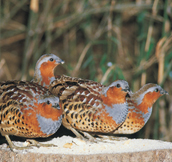
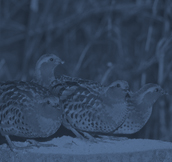 Bambusicola thoracica (Bamboo Partridge) Phasianidae
Bambusicola thoracica (Bamboo Partridge) Phasianidae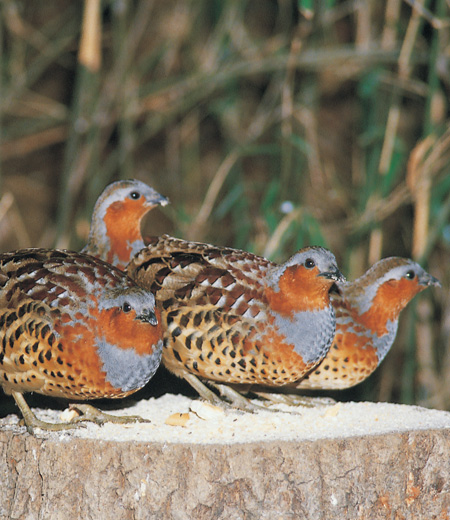 This is a foreign species native to southern China. After released 20 of them in Tokyo and Kanagawa prefectures in 1919 (Taisho 8), they are now distributed throughout Japan. They are found in woods, shrubs and grasslands in flatlands. They live in a group from autumn to early spring and feed on seeds, nuts, young leaves and buds of trees and earthworms. Their voice sounds like “come here” (chottokoi) in Japanese and had often been used in TV programs, movies and samurai dramas as the birds that live in satoyama (satoyama is where residential area and woods space coexist in a rural area). The breeding season is from May to June. They dig shallow holes in shrubs and build a nest with fallen plants and lay seven to eight eggs in a season.
This is a foreign species native to southern China. After released 20 of them in Tokyo and Kanagawa prefectures in 1919 (Taisho 8), they are now distributed throughout Japan. They are found in woods, shrubs and grasslands in flatlands. They live in a group from autumn to early spring and feed on seeds, nuts, young leaves and buds of trees and earthworms. Their voice sounds like “come here” (chottokoi) in Japanese and had often been used in TV programs, movies and samurai dramas as the birds that live in satoyama (satoyama is where residential area and woods space coexist in a rural area). The breeding season is from May to June. They dig shallow holes in shrubs and build a nest with fallen plants and lay seven to eight eggs in a season.
●Body length about 27 cm
●Season January to December (resident bird: a bird that stays in the same area all year round)(未翻訳)鳴き声を聞く
-
Anas poecilorhyncha (Spot-billed Duck) Anatidae
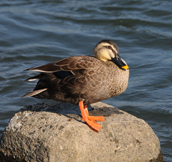
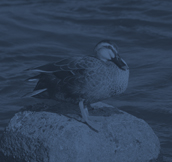 Anas poecilorhyncha (Spot-billed Duck) Anatidae
Anas poecilorhyncha (Spot-billed Duck) Anatidae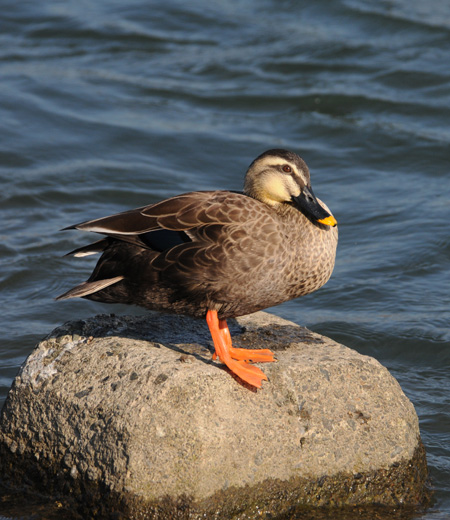 This duck is distributed throughout Japan. They are found in the waterside including lakes, ponds, rivers, paddy fields and ponds at parks. They raise chicks even at man-made ponds at office streets in cities often covered on TV programs. Most female ducks have brighter colored wings but this species has almost the same color with males. They are normally active at night but after increased in number, they are often seen eating food at parks in cities during the daytime. They prefer fruits of plants but they are omnivorous and also feed on fish and insects. The breeding season is from April to early July. They build a nest with fallen leaves and plants covered with feather of parents’ breast in shrubs near waterside and lay eight to thirteen eggs in a season.
This duck is distributed throughout Japan. They are found in the waterside including lakes, ponds, rivers, paddy fields and ponds at parks. They raise chicks even at man-made ponds at office streets in cities often covered on TV programs. Most female ducks have brighter colored wings but this species has almost the same color with males. They are normally active at night but after increased in number, they are often seen eating food at parks in cities during the daytime. They prefer fruits of plants but they are omnivorous and also feed on fish and insects. The breeding season is from April to early July. They build a nest with fallen leaves and plants covered with feather of parents’ breast in shrubs near waterside and lay eight to thirteen eggs in a season.
●Body Length about 61 cm
●Season January to December (resident bird: a bird that stays in the same area all year round) -
Streptopelia orientalis (Oriental Turtle Dove) Columbidae
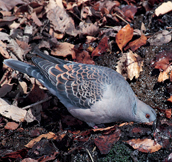
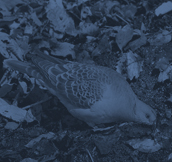 Streptopelia orientalis (Oriental Turtle Dove) Columbidae
Streptopelia orientalis (Oriental Turtle Dove) Columbidae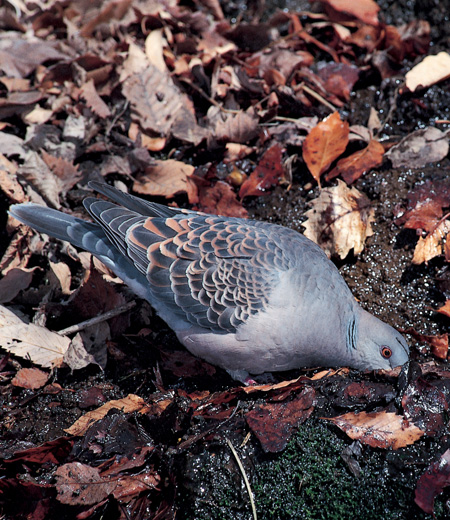 The Japanese name Kijibato was named because the red-brown feather patterns resemble pheasants. They are also called Yamabato literally meaning birds in mountains but they are distributed widely even at parks and street trees in cities. They rest on electric wires and chirp with low voice “coo coo coo”. They feed mainly on nuts of trees and plants, also breads and cereals. The married couple lives together and normally has a good relationship. During the breeding season, males bow repeatedly and fly upward fast and fly down for courtship. They build a simple nest with twigs from April to July and lay two eggs in a season.
The Japanese name Kijibato was named because the red-brown feather patterns resemble pheasants. They are also called Yamabato literally meaning birds in mountains but they are distributed widely even at parks and street trees in cities. They rest on electric wires and chirp with low voice “coo coo coo”. They feed mainly on nuts of trees and plants, also breads and cereals. The married couple lives together and normally has a good relationship. During the breeding season, males bow repeatedly and fly upward fast and fly down for courtship. They build a simple nest with twigs from April to July and lay two eggs in a season.
●Body Length about 33 cm
●Season January to December (resident bird: a bird that stays in the same area all year round) -
Sphenurus sieboldii (Japanese Green Pigeon) Columbidae
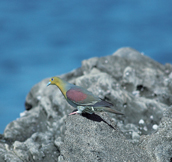
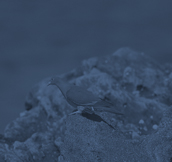 Sphenurus sieboldii (Japanese Green Pigeon) Columbidae
Sphenurus sieboldii (Japanese Green Pigeon) Columbidae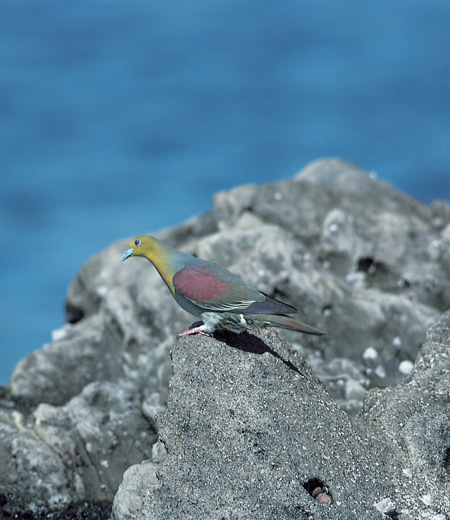 They are beautiful birds with a yellow-green body with a light blue bill. Male and female have almost the same body color but the male has purple feathers on wings. They live in a group in broad-leaved forests with Quercus acutissima, maple trees, Quercus crispula blume and hardly ever come out to open spaces. They feed on nuts like acorns, buds and fruits of trees. From early summer to autumn, they fly out to the coast to drink seawater and to hot springs for salty water. During the breeding season, males chirp like “oh ah oh” with lonely tones. In June, they build a dish-shaped nest with twigs and vines on a tree and lay two eggs in a season.
They are beautiful birds with a yellow-green body with a light blue bill. Male and female have almost the same body color but the male has purple feathers on wings. They live in a group in broad-leaved forests with Quercus acutissima, maple trees, Quercus crispula blume and hardly ever come out to open spaces. They feed on nuts like acorns, buds and fruits of trees. From early summer to autumn, they fly out to the coast to drink seawater and to hot springs for salty water. During the breeding season, males chirp like “oh ah oh” with lonely tones. In June, they build a dish-shaped nest with twigs and vines on a tree and lay two eggs in a season.
●Body Length about 33 cm
●Season January to December (resident bird: a bird that stays in the same area all year round, and wandering bird: a bird that has different areas for breeding and spending winter)(未翻訳)鳴き声を聞く
-
Columba livia (Rock Dove) Columbidae
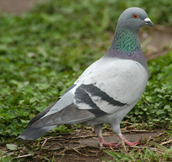
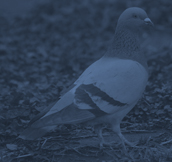 Columba livia (Rock Dove) Columbidae
Columba livia (Rock Dove) Columbidae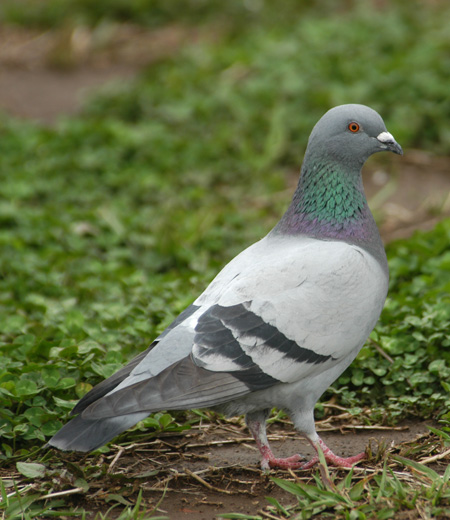 This is seen daily at parks and shrines, and commonly known as “dobato” in Japanese. This species is a foreign species bred to courier pigeons in Europe. Most of them have shiny purple and green feathers around neck and two black lines on wings but wings vary to black, gray, nut-brown due to breeding. Although most of birds need to hold water in a mouth once and swallow with their head lifted, they have a unique habit to drink water directly. They raise chicks with secretions called pigeon milk produced in crop.
This is seen daily at parks and shrines, and commonly known as “dobato” in Japanese. This species is a foreign species bred to courier pigeons in Europe. Most of them have shiny purple and green feathers around neck and two black lines on wings but wings vary to black, gray, nut-brown due to breeding. Although most of birds need to hold water in a mouth once and swallow with their head lifted, they have a unique habit to drink water directly. They raise chicks with secretions called pigeon milk produced in crop.
●Size about 31 to 34 cm
●Season January to December (resident bird: a bird that stays in the same area all year round) -
Gorsakius goisagi (Japanese Night Heron) Ardeidae
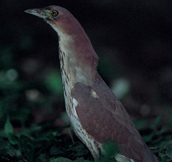
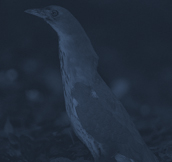 Gorsakius goisagi (Japanese Night Heron) Ardeidae
Gorsakius goisagi (Japanese Night Heron) Ardeidae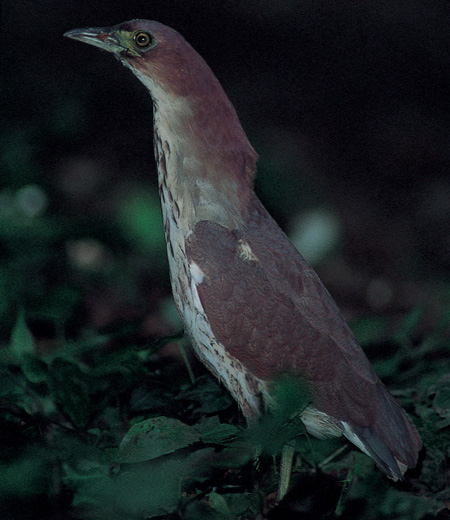 This is in the Ardeidae family and breeds during summer only in Japan. They live alone or in pairs in shady forests near streams of low elevations. The body color is dark brown for both males and females. They rest under shrubs during daytime and become active in the late afternoon. They hunt for earthworms, crayfish, frogs and fish in streams or ponds. When feeling danger, they lift a bill upward and stand still camouflaging their body to tree branches. The breeding season is from May to July and the males chirp “boo boo” with low voices repeatedly to ask females to mate. They build a dish-shaped nest with twigs on a branch extended over streams and lay four to five eggs in a season. After parenting in summer, they fly to Southeast Asia to spend winter.
This is in the Ardeidae family and breeds during summer only in Japan. They live alone or in pairs in shady forests near streams of low elevations. The body color is dark brown for both males and females. They rest under shrubs during daytime and become active in the late afternoon. They hunt for earthworms, crayfish, frogs and fish in streams or ponds. When feeling danger, they lift a bill upward and stand still camouflaging their body to tree branches. The breeding season is from May to July and the males chirp “boo boo” with low voices repeatedly to ask females to mate. They build a dish-shaped nest with twigs on a branch extended over streams and lay four to five eggs in a season. After parenting in summer, they fly to Southeast Asia to spend winter.
●Body Length about 49 cm
●Season April to September (resident bird: a bird that stays in the same area all year round) -
Nycticorax nycticorax (Black-crowned Night Heron) Ardeidae
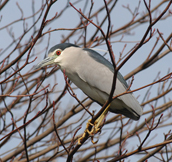
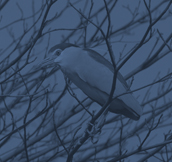 Nycticorax nycticorax (Black-crowned Night Heron) Ardeidae
Nycticorax nycticorax (Black-crowned Night Heron) Ardeidae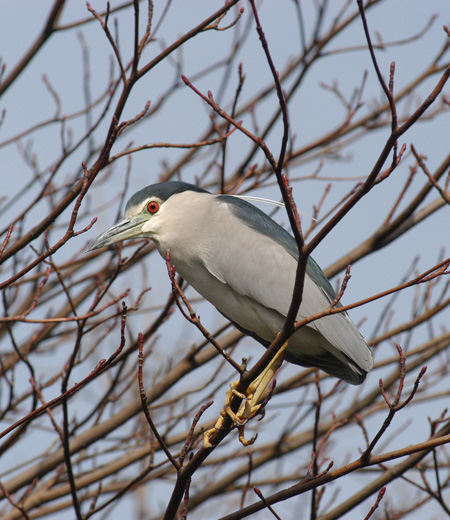 Just like other species in the Ardeidae family, they create the habitat area called colony in forests from flatlands to hills. They stay in a colony during daytime and hunt for fish, frogs and crayfish at waterside such as rivers, bogs and ponds at night. They wait for preys to come closer and catch immediately with bills. Males and females have same body color and there are people who say that they are like penguins. Adults have two decorative feathers on the back of a head. The young adults have white patterns on the brown body. They are called Hoshigoi and look completely different from adult birds. The breeding season is from April to August. They build nests with twigs on trees in a colony, and lay four to six eggs in a season.
Just like other species in the Ardeidae family, they create the habitat area called colony in forests from flatlands to hills. They stay in a colony during daytime and hunt for fish, frogs and crayfish at waterside such as rivers, bogs and ponds at night. They wait for preys to come closer and catch immediately with bills. Males and females have same body color and there are people who say that they are like penguins. Adults have two decorative feathers on the back of a head. The young adults have white patterns on the brown body. They are called Hoshigoi and look completely different from adult birds. The breeding season is from April to August. They build nests with twigs on trees in a colony, and lay four to six eggs in a season.
●Body Length about 57 cm
●Season January to December (resident bird: a bird that stays in the same area all year round) -
Ardea cinerea (Grey Heron) Ardeidae
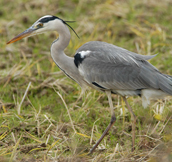
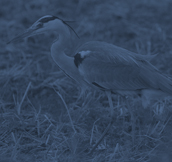 Ardea cinerea (Grey Heron) Ardeidae
Ardea cinerea (Grey Heron) Ardeidae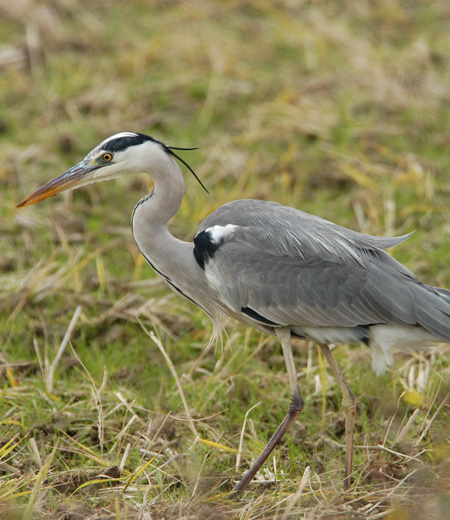 This is the largest heron distributed in Japan. They have skinny bodies with long legs and necks. The body color of males and females is bluish gray. Adults have decorative black feathers on a head but not on young birds. They live near coastline, mudflats, rivers, lakes, ponds and swamps, and sometimes come to streams on Mt. Takao. They rest in a group during daytime and hunt for preys from late afternoon to the following morning. They feed on fish, frogs, crayfish and sometimes snakes, rats and baby birds. They catch small fish with a bill and catch large fish by piercing them with the tip of a bill. They build a colony for breeding and build a dish-shaped nest with twigs on tall trees in forests. The breeding season is from April to May and they lay three to six eggs in a season.
This is the largest heron distributed in Japan. They have skinny bodies with long legs and necks. The body color of males and females is bluish gray. Adults have decorative black feathers on a head but not on young birds. They live near coastline, mudflats, rivers, lakes, ponds and swamps, and sometimes come to streams on Mt. Takao. They rest in a group during daytime and hunt for preys from late afternoon to the following morning. They feed on fish, frogs, crayfish and sometimes snakes, rats and baby birds. They catch small fish with a bill and catch large fish by piercing them with the tip of a bill. They build a colony for breeding and build a dish-shaped nest with twigs on tall trees in forests. The breeding season is from April to May and they lay three to six eggs in a season.
●Body Length about 93 cm
●Season January to December (resident bird: a bird that stays in the same area all year round)
Others
Mt. Takao has abundant nature with warm-temperature forests and temperate forests. There are a lot more species could be called as "treasure" inhabits other than explained in animals, insects and birds section. Spiders is one of them because they are beneficial insects and its prey is destructive insects. Over 300 species including rare ones inhabits and Mt. Takao is the mountain with the largest number of species of spiders and widely known as a paradise for spiders.
-
Plestiodon finitimus Scincidae
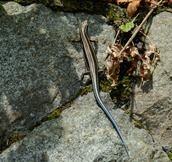
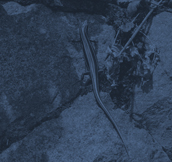 Plestiodon finitimus Scincidae
Plestiodon finitimus Scincidae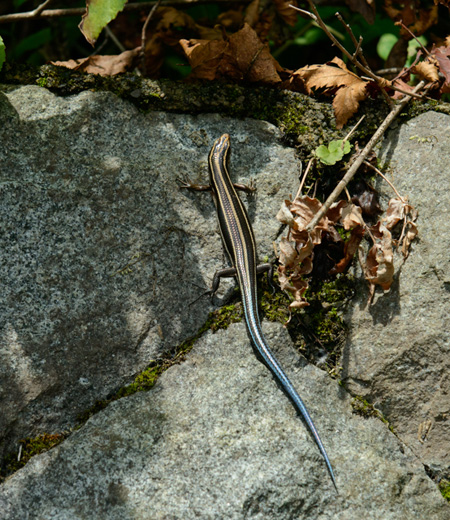 They inhabit in eastern Japan Hosyu area from Kyoto to Wakayama except for Hokkaido and Izu Peninsula.
They inhabit in eastern Japan Hosyu area from Kyoto to Wakayama except for Hokkaido and Izu Peninsula.
It was thought that they used to be the same species as Plestiodon japnicus which inhabits in western Japan, but that they turned out to be the different species in 2012,and thus the name of Plestiodon japonicus was given to the one that inhabit in eastern Japan (The name of the one for the western Japan is the same, not changed).
They dwell at the grasslands and the mountain forest from low altitudes to high land, and we can often see them sunbathe on the ground of the mountain trail and on a sunny slope at Mt. Takao.
The body is tinged with glowing brownish yellow, and smooth body surface to touch.
They have as 1.5 long a tail as their head trunk. Larva has a black body and a tail tinged with metallic blue, which makes them stand out well.
They are quick in move and very cautious, so that when they see figures of people they immediately run into within the shadows. Nevertheless, when caught by the enemies they can cut their tail themselves to run, which is called ‘Jigiri’ (cutting oneself by a part of their body).
The eat baits such as small insects, spiders, and Porcellio scaber.
In June they lay eggs and a female parent incubates eggs.
●Size about 15 to 25 cm
●Season about April to October -
Takydromus tachydromoides (Japanese Grass Lizard) Lacertidae
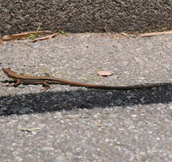
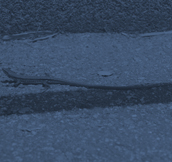 Takydromus tachydromoides (Japanese Grass Lizard) Lacertidae
Takydromus tachydromoides (Japanese Grass Lizard) Lacertidae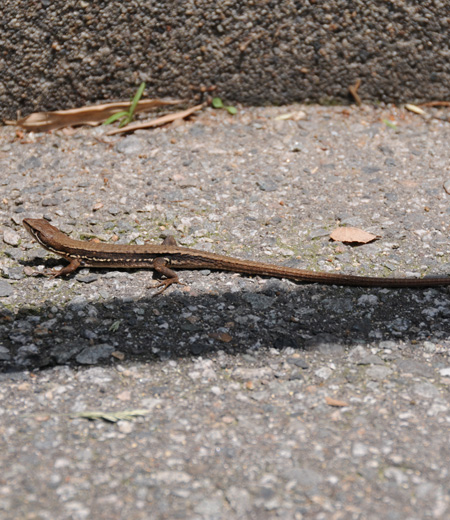 Main region: Hokkaido, Honshu, Shikoku, Kyushu, Yaku Island, Tanega Island and Nakanoshima Island. Found in grasslands and shrubs from flatlands to low elevations and also around residential areas and often see them sunbathing on rock fences and rocks at gardens. The Japanese name Nihon-kana-hebi literally meaning Japanese cute snakes but they are a group of lizards, not snakes. The biggest difference from Japanese five-lined skink is to have rough surfaced scales. Are active during daytime and sleep on fallen leaves or grass at night. Are predators and feed on spiders and porcellio scabers. Have distinct long tails and the length is twice as long as the length of head to body. Are able to cut own tails to protect itself from enemies. The body color is brown from back to side of abdomen and white on abdomen. Have one white line from under the eye to the side of abdomen.
Main region: Hokkaido, Honshu, Shikoku, Kyushu, Yaku Island, Tanega Island and Nakanoshima Island. Found in grasslands and shrubs from flatlands to low elevations and also around residential areas and often see them sunbathing on rock fences and rocks at gardens. The Japanese name Nihon-kana-hebi literally meaning Japanese cute snakes but they are a group of lizards, not snakes. The biggest difference from Japanese five-lined skink is to have rough surfaced scales. Are active during daytime and sleep on fallen leaves or grass at night. Are predators and feed on spiders and porcellio scabers. Have distinct long tails and the length is twice as long as the length of head to body. Are able to cut own tails to protect itself from enemies. The body color is brown from back to side of abdomen and white on abdomen. Have one white line from under the eye to the side of abdomen.
●Body Length about 16 to 27 cm
●Season April to October -
Elaphe climacophora (Japanese Rat Snake) Colubridae
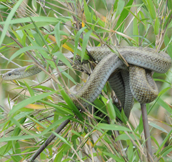
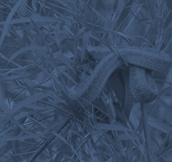 Elaphe climacophora (Japanese Rat Snake) Colubridae
Elaphe climacophora (Japanese Rat Snake) Colubridae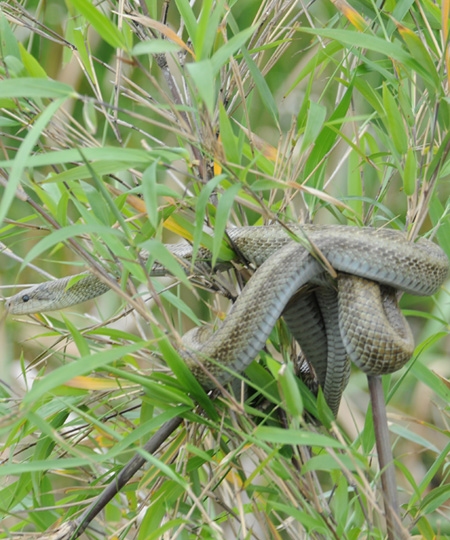 Main region: Hokkaido to Kyushu, Kunashiri Island, Sado Island and Goto Islands. Found in forests and grasslands from flatlands to mountains and also in ceilings. Most commonly known snake in Honshu. The body color is brownish olive but varies by individual species. The body size of large species is more than 2 meters but they are calm and not poisonous. Are good at climbing up trees by using keeled scales, even vertical trees or power poles and hunt for baby birds or eggs in bird’s nests. The white species called shirohebi literally meaning white snakes are the albino species of this species. This white rat snakes live in Iwakuni city of Yamaguchi prefectures and are designated as protected species.
Main region: Hokkaido to Kyushu, Kunashiri Island, Sado Island and Goto Islands. Found in forests and grasslands from flatlands to mountains and also in ceilings. Most commonly known snake in Honshu. The body color is brownish olive but varies by individual species. The body size of large species is more than 2 meters but they are calm and not poisonous. Are good at climbing up trees by using keeled scales, even vertical trees or power poles and hunt for baby birds or eggs in bird’s nests. The white species called shirohebi literally meaning white snakes are the albino species of this species. This white rat snakes live in Iwakuni city of Yamaguchi prefectures and are designated as protected species.
●Body Length about 100 to 200 cm
●Season April to October -
Elaphe quadrivirgata (Japanese Striped Snake) Colubridae
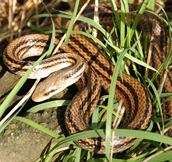
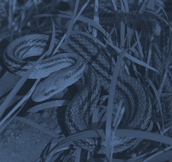 Elaphe quadrivirgata (Japanese Striped Snake) Colubridae
Elaphe quadrivirgata (Japanese Striped Snake) Colubridae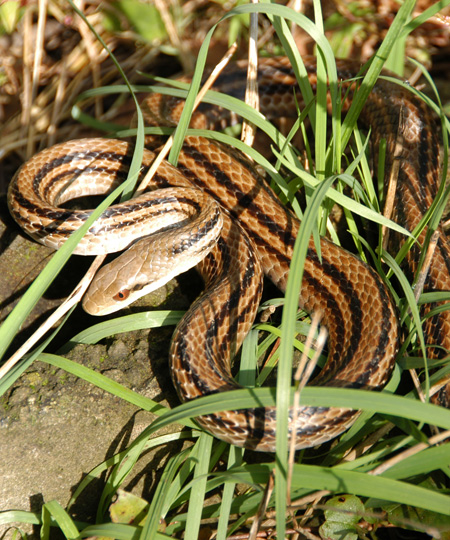 Main region: Hokkaido, Honshu, Shikoku, Kunashiri Island, Sado Island and Osumi Islands. Found in sunny croplands, riverbeds and grasslands from flatlands to mountains as they often bath in the sun. Are commonly known snakes like Japanese forest ratsnake and tiger keelback. Body patterns vary by individual species but most of them have four black stripes as the Japanese name Shima-hebi literally meaning stripe snake states. Some species have black body and called karasu-hebi literally meaning crow snake. Are active during daytime and hunt for frogs, rats, lizards, salamanders and eggs of birds. Also have a habit to eat another snakes such as Japanese forest ratsnake and amphiesma vibakari. When sensing dangers, threat others by making S shape with body.
Main region: Hokkaido, Honshu, Shikoku, Kunashiri Island, Sado Island and Osumi Islands. Found in sunny croplands, riverbeds and grasslands from flatlands to mountains as they often bath in the sun. Are commonly known snakes like Japanese forest ratsnake and tiger keelback. Body patterns vary by individual species but most of them have four black stripes as the Japanese name Shima-hebi literally meaning stripe snake states. Some species have black body and called karasu-hebi literally meaning crow snake. Are active during daytime and hunt for frogs, rats, lizards, salamanders and eggs of birds. Also have a habit to eat another snakes such as Japanese forest ratsnake and amphiesma vibakari. When sensing dangers, threat others by making S shape with body.
●Body Length about 80 to 200 cm
●Season April to about October -
Elaphe conspicillata (Japanese Forest Ratsnake) Colubridae
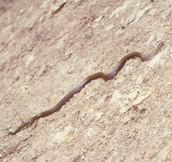
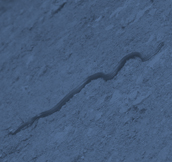 Elaphe conspicillata (Japanese Forest Ratsnake) Colubridae
Elaphe conspicillata (Japanese Forest Ratsnake) Colubridae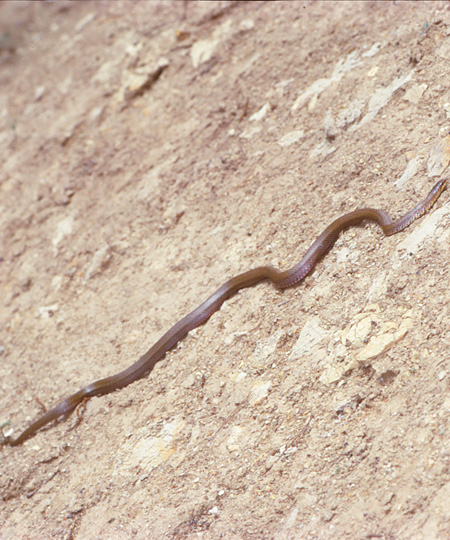 Main region: Hokkaido, Honshu, Shikoku, Kyushu, Kunashiri Island, Izu Islands and Tanega Island. Found in croplands and grasslands in flatlands but mainly in forests of low elevations. Have small head and does not have skinny neck that is suitable for living underground as the Japanese name Jimuguri literally meaning to live underground states. Feed on rat live underground and small moles. Hunt these preys by searching their nest tunnels and sneaking inside the nests. Are calm and not poisonous and does not bite. Only bite when they are sensing dangers like human beings trying to touch their body. Sometimes release grass-like smelled secretions from anal glands. Go dormant in winter but often stay underground even in summer as they are not so bearable in hot weather.
Main region: Hokkaido, Honshu, Shikoku, Kyushu, Kunashiri Island, Izu Islands and Tanega Island. Found in croplands and grasslands in flatlands but mainly in forests of low elevations. Have small head and does not have skinny neck that is suitable for living underground as the Japanese name Jimuguri literally meaning to live underground states. Feed on rat live underground and small moles. Hunt these preys by searching their nest tunnels and sneaking inside the nests. Are calm and not poisonous and does not bite. Only bite when they are sensing dangers like human beings trying to touch their body. Sometimes release grass-like smelled secretions from anal glands. Go dormant in winter but often stay underground even in summer as they are not so bearable in hot weather.
●Body Length about 70 to 100 cm
●Season April to October -
Amphiesma vibakari vibakari (Japanese Keelback) Colubridae
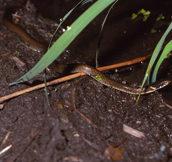
 Amphiesma vibakari vibakari (Japanese Keelback) Colubridae
Amphiesma vibakari vibakari (Japanese Keelback) Colubridae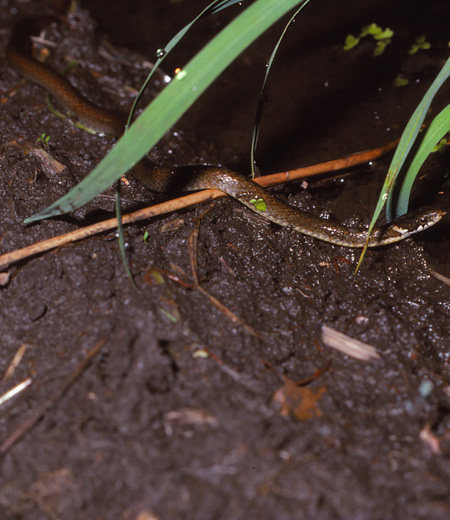 Main region: Honshu, Shikoku, Kyushu, Sado Island and Iki Island, Oki Island and Goto Islands. Small snake found in wide varieties of areas including forests, grasslands, paddy fields and croplands. The Japanese name Hibakari came from its literally meaning to be bitten or live only a day, however they are not poisonous and does not bite because they are very calm. When sensing dangers, threat others by making S shape with body. Are active on the ground but mostly stay underwater as they are good at swimming compare to other snakes. Feed on waterside species including small frogs or tadpoles and even hunt for fishes in water such as loaches.
Main region: Honshu, Shikoku, Kyushu, Sado Island and Iki Island, Oki Island and Goto Islands. Small snake found in wide varieties of areas including forests, grasslands, paddy fields and croplands. The Japanese name Hibakari came from its literally meaning to be bitten or live only a day, however they are not poisonous and does not bite because they are very calm. When sensing dangers, threat others by making S shape with body. Are active on the ground but mostly stay underwater as they are good at swimming compare to other snakes. Feed on waterside species including small frogs or tadpoles and even hunt for fishes in water such as loaches.
●Body Length about 40 to65 cm
●Season April to October -
Rhabdophis tigrinus (Tiger Keelback) Colubridae
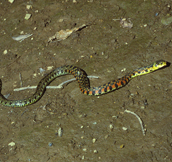
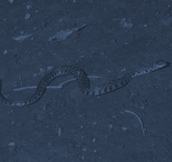 Rhabdophis tigrinus (Tiger Keelback) Colubridae
Rhabdophis tigrinus (Tiger Keelback) Colubridae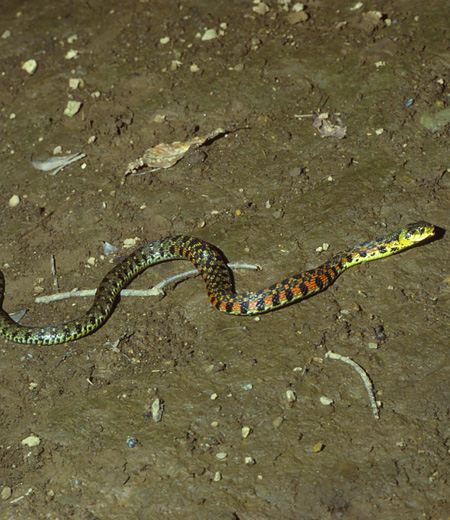 Main region: Honshu, Shikoku, Kyushu, Sado Islands, Goto Islands, Yaku Island and Tanega Island. Found in flatlands to low elevations and prefer paddy fields and swampy areas. Feed on frogs, lizards and fish but prefer frogs the best. This species is large in body size and even feed on toads which most of other snakes does not. Are not harmful to human beings compare to habu and pit viper but it is dangerous to be bitten because there are poisonous fangs deep inside of mouth. The poison causes death depending on the condition of human body. Also have poison in glands at the back of neck. It is dangerous even to step on them because the skin of poisonous glands will break and poisonous secretion will splash. Normally stay calm and does not bite unless human beings try to touch or catch them.
Main region: Honshu, Shikoku, Kyushu, Sado Islands, Goto Islands, Yaku Island and Tanega Island. Found in flatlands to low elevations and prefer paddy fields and swampy areas. Feed on frogs, lizards and fish but prefer frogs the best. This species is large in body size and even feed on toads which most of other snakes does not. Are not harmful to human beings compare to habu and pit viper but it is dangerous to be bitten because there are poisonous fangs deep inside of mouth. The poison causes death depending on the condition of human body. Also have poison in glands at the back of neck. It is dangerous even to step on them because the skin of poisonous glands will break and poisonous secretion will splash. Normally stay calm and does not bite unless human beings try to touch or catch them.
●Body Length about 70 to 150 cm
●Season April to October -
Gloydius blomhoffii Viperinae
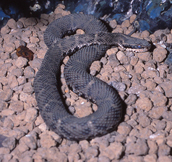
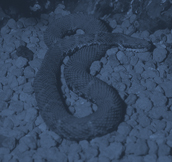 Gloydius blomhoffii Viperinae
Gloydius blomhoffii Viperinae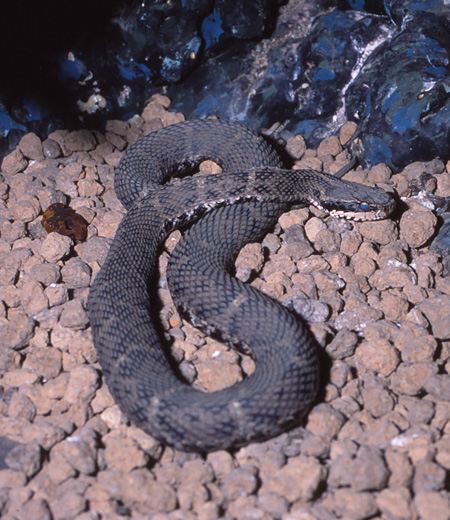 They live widely in Hokkaido, main land Honsyu, Shikoku, Kyusyu as well as Osumi-shoto Islands and Izu Peninsula.
They live widely in Hokkaido, main land Honsyu, Shikoku, Kyusyu as well as Osumi-shoto Islands and Izu Peninsula.
Mainly they inhabit in the bushes along the mountain streams at low lands, in the forest, and woods in the mountain district, but we sometimes see them in arable land.
They are very notorious poisonous snake, and there are so many incidental deaths that people die.
Their body is tinged with pale dark brown as base, usually have elliptically-shaped mottles with black mottles in their center in line, while some tinged with strong red, some entirely in black.
There are varietas. Basically, they are nocturnal animal, around the time when temperatures were much lower, they are active even during the daytime.
We sometimes see them at Mt. Takao, we, ordinary mountain climbers hardly come across them if we walk within the specified Trail rout areas.
If we happen to encounter them, keep our hands off, keep ourselves away 1m away, and let them pass, they do not attack us.
Their main bait is such small animals and insects as rats, lizards, and frogs.
They can use a sense of vision and a sense of smell as well as an organ called ‘a pit’ near the nose to detect infrared-ray to find baits.
They are an ovoviviparous animal (Rantaisei: a female spider hatches the eggs inside their own body, and then lays them as baby spiders), lay about 10 baby spiders from the end of the summer till he autumn.
Size about 45 to 60 cm
Season April to October -
Hynobius tokyoensis (Tokyo Salamander) Hynobiidae
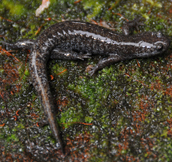
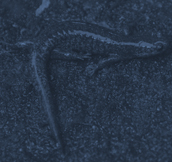 Hynobius tokyoensis (Tokyo Salamander) Hynobiidae
Hynobius tokyoensis (Tokyo Salamander) Hynobiidae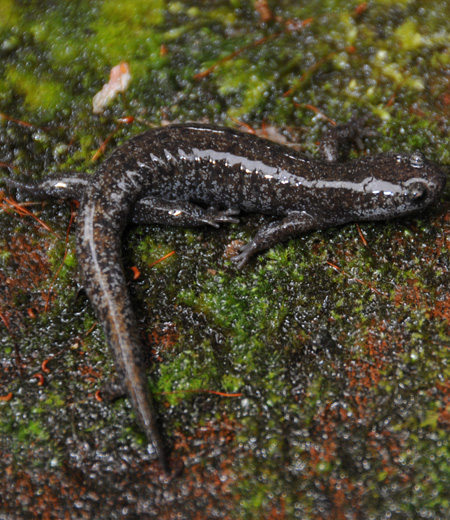 Main region: Kanto area (except Gunma prefecture) and some parts of Fukushima prefecture. Found in forests on hills and waterside in mountains and mostly live on the ground except breeding season. The baby is like the small version of axolotl and live mostly underwater. Feed on insects live on the ground including earthworms, porcellio scabers, spiders and wood louses. The body color varies by individual species but mostly dark-brown with black spots on entire body. Are active at night and it is difficult to find during daytime as they are normally hide alone underground and under rocks. In autumn, become even more active to hunt for preys in order to prepare for going dormant in winter and breeding. The breeding season is from February to March and often found in water with no flow including ponds or ditches of paddy fields.
Main region: Kanto area (except Gunma prefecture) and some parts of Fukushima prefecture. Found in forests on hills and waterside in mountains and mostly live on the ground except breeding season. The baby is like the small version of axolotl and live mostly underwater. Feed on insects live on the ground including earthworms, porcellio scabers, spiders and wood louses. The body color varies by individual species but mostly dark-brown with black spots on entire body. Are active at night and it is difficult to find during daytime as they are normally hide alone underground and under rocks. In autumn, become even more active to hunt for preys in order to prepare for going dormant in winter and breeding. The breeding season is from February to March and often found in water with no flow including ponds or ditches of paddy fields.
●Body Length about 8 to 13 cm
●Season April to October -
Hynobius kimurae (Hida Salamander) Hynobiidae
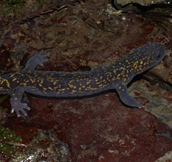
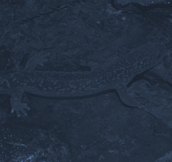 Hynobius kimurae (Hida Salamander) Hynobiidae
Hynobius kimurae (Hida Salamander) Hynobiidae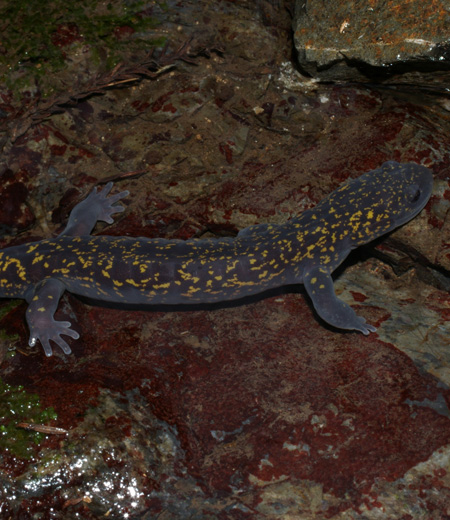 Main region: Kanto area, Chubu area, Hokuriku area, Kinki area and Chugoku area. Found in appropriate humid areas of valleys and streamside in mountain forests. The body color is purple-brown with yellow spots like sprinkles gold leaf. Are active at night and daytime of rainy days. Are mostly rest under the rocks and fallen leaves and become active after dark and hunt for earthworms, slugs, spiders and small insects. Adults mostly live on the ground but move to waterside to lay eggs during breeding season. Lay eggs in upstream of streams with moderate water flow and lay eggs in egg sac on the rocky ground. Egg sac is bluish fluorescent color.
Main region: Kanto area, Chubu area, Hokuriku area, Kinki area and Chugoku area. Found in appropriate humid areas of valleys and streamside in mountain forests. The body color is purple-brown with yellow spots like sprinkles gold leaf. Are active at night and daytime of rainy days. Are mostly rest under the rocks and fallen leaves and become active after dark and hunt for earthworms, slugs, spiders and small insects. Adults mostly live on the ground but move to waterside to lay eggs during breeding season. Lay eggs in upstream of streams with moderate water flow and lay eggs in egg sac on the rocky ground. Egg sac is bluish fluorescent color.
●Body Length about 10 to18 cm
●Season All year
Selected
Takao 599 museum has all kinds of animals inhabit in Mt. Takao in various ways of exhibitions such as seasonal wild plants preserved in acrylic and all kinds of animals specimens inhibits in Mt. Takao. On the "NATURE WALL," stuffed animals are displayed and shows the movie to introduce the dynamic nature of Mt. Takao.
-
(日本語) 高尾山がつなぐ野鳥と木の実

 (日本語) 高尾山がつなぐ野鳥と木の実
(日本語) 高尾山がつなぐ野鳥と木の実 2021年12月1日~2022年1月31日「高尾山がつなぐ野鳥と木の実」
2021年12月1日~2022年1月31日「高尾山がつなぐ野鳥と木の実」
高尾山で見られる野鳥たちとカラフルな木の実をご紹介します。秋から冬にかけて実る木の実は、野鳥たちのごちそう!登る前に立ち寄って、野鳥と出会うきっかけを探してみませんか? -
(日本語) チョウが舞う高尾山

 (日本語) チョウが舞う高尾山
(日本語) チョウが舞う高尾山
-
高尾山から広がるスミレの世界

 高尾山から広がるスミレの世界
高尾山から広がるスミレの世界
-
(日本語) 高尾山に暮らすタヌキ展

 (日本語) 高尾山に暮らすタヌキ展
(日本語) 高尾山に暮らすタヌキ展 2021年2月1日~2021年3月31日「高尾山に暮らすタヌキ展」
2021年2月1日~2021年3月31日「高尾山に暮らすタヌキ展」
人里近くに生息する哺乳類であるタヌキ。タヌキが高尾の森で、どんなものを食べ、どのように他の生きもの達と関わり合っているのか。高尾山での暮らしを通してその生態に迫ります。 -
Papilio xuthus(Asian Swallowtail) Papilionidae

 Papilio xuthus(Asian Swallowtail) Papilionidae
Papilio xuthus(Asian Swallowtail) Papilionidae Main Region: Hokkaido, Honshu, Shikoku, Kyushu, Okinawa, Sado Island and Yaku Island.
Main Region: Hokkaido, Honshu, Shikoku, Kyushu, Okinawa, Sado Island and Yaku Island.
Well-known butterfly and often seen in residential areas in cities as well as suburban areas because caterpillars feed on plants in rutaceae family which often planted at gardens or hedges.
This species is so-called swallowtails.
Fly to sunny trees and grasslands and feed on nectar of ericaceae, cirsium and cayratia japonica.
Color of wings is less yellowish yellow-white to white than papilio machaon.
Black lines along wing veins create complicated patterns.
Have blue and red patterns at the bottom of hind wings.
The difference between male and female is the tip of abdomen, male is sharp-shaped because of the reproductive organs and female is more round-shaped.
●Wingspan (length when fore wings are open) about 65 to 90 mm
●Adult Flight Season April to about October -
Papilio machaon (Old World Swallowtail) Papilionidae

 Papilio machaon (Old World Swallowtail) Papilionidae
Papilio machaon (Old World Swallowtail) Papilionidae Main Region: Hokkaido, Honshu, Shikoku, Kyushu, Sado Island, Goto Islands and Yaku Island.
Main Region: Hokkaido, Honshu, Shikoku, Kyushu, Sado Island, Goto Islands and Yaku Island.
Prefer sunny grasslands and paddy fields from flatlands to mountains.
Often seen at parks and residential areas in cities.
Adults are also found from flatlands to high lands of 3000 meters elevations, thus living area varies to different elevations.
Fly to green grasslands during the daytime and feed on nectar of ericaceae and cirsium.
Caterpillars feed on leaves of plants in apiaceae family including water dropwort javanica and parsleys.
Body is similar to swallowtail but can be distinguished by the wing color, which more strong yellow as the Japanese name Ki-ageha literally meaning yellow swallowtail states.
And at the base of wings are black without any patterns.
Male holds territory at high elevations, and is often seen around mountain peak.
●Wingspan about 70 to 90 mm
●Adult Flight Season April to about September -
Papilio protenor (Spangle) Papilionidae

 Papilio protenor (Spangle) Papilionidae
Papilio protenor (Spangle) Papilionidae Main Region: Honshu (South of southern Tohoku area), Shikoku, Kyushu, Okinawa and Yaeyama Islands.
Main Region: Honshu (South of southern Tohoku area), Shikoku, Kyushu, Okinawa and Yaeyama Islands.
Prefer shadowy areas and found in woody forests, sometimes seen at parks and residential areas in cities.
In Mt. Takao, often found at mountain trails.
Body color is mat black and tails at the lower tips of hind wings are smaller than other species in papilionidae.
Do not have strong characteristics so it is easy to identify.
On the back of hind wings, male has red spots only on the back and female has them on both sides.
Fly to shady area avoiding sun and feed on nectar of plants in ericaceae family.
Caterpillars feed on leaves of plants in rutaceae family.
●Wingspan about 80 to 120 mm
●Adult Flight Season April to about October -
Papilio macilentus (The Long Tail Spangle) Papilionidae

 Papilio macilentus (The Long Tail Spangle) Papilionidae
Papilio macilentus (The Long Tail Spangle) Papilionidae Main Region: Hokkaido, Honshu, Shikoku, Kyushu, Okushiri Island, Sado Island and Shodo Island.
Main Region: Hokkaido, Honshu, Shikoku, Kyushu, Okushiri Island, Sado Island and Shodo Island.
Found in woods on hills or at streamsides in mountains.
Wings are shiny black and have crescent moon-shaped red patterns on edges of hind wings.
These patterns on female are more distinct.
Only male have white front edges of hind wings but this is often covered by fore wings.
Similar to papilio protenor but this species have long tails as Japanese name Onaga-ageha literally meaning long tail swallowtail states.
Fly around streamsides in mountains and feed on nectar from azalea and lilium medeoloides.
Caterpillars feed on leaves of orixa japonica and Japanese pepper.
Only male suck waters at paddles and swamps sometimes do in groups.
●Wingspan about 90 to 110 mm
●Adult Flight Season April to about September -
Papilio bianor (Chinese Peacock) Papilionidae

 Papilio bianor (Chinese Peacock) Papilionidae
Papilio bianor (Chinese Peacock) Papilionidae Main Region: Hokkaido, Honshu, Shikoku, Kyushu and other isolated islands including Goto Islands.
Main Region: Hokkaido, Honshu, Shikoku, Kyushu and other isolated islands including Goto Islands.
Found in forests from flatlands to mountains.
Wing color is black and covered by blue-green scales and the colors and brightness differ by viewing angles and are very beautiful.
The back of wings is black with red spots on hind wings.
Male has mat and hairy part on fore wings that are to distinguish male from female.
Is active during daytime and fly fast and feed on nectar of plants in ericaceae family and moss phlox.
Caterpillars feed on leaves of orixa japonica and Japanese pepper.
Only male suck fresh water on mountain trails in Mt. Takao.
Male in papilionidae family fly on the same route regularly, which is called flyway.
●Wingspan about 80 to 110 mm
●Adult Flight Season April to about September -
Papilio maackii(Maackii Peacock) Papilionidae

 Papilio maackii(Maackii Peacock) Papilionidae
Papilio maackii(Maackii Peacock) Papilionidae Main Region: Hokkaido, Honshu, Shikoku, Kyushu, Okinawa, Sado Island, Tanega Island and Yaku Island.
Main Region: Hokkaido, Honshu, Shikoku, Kyushu, Okinawa, Sado Island, Tanega Island and Yaku Island.
Found in forests from low elevations to mountains, also in woods along coastline.
Is not too appealing but very beautiful with black wings covered by blue scales creating bright green or deep blue by different viewing angles.
Some says that this species is the most beautiful butterfly representing Japan.
Bright belt-like colors on the back of fore and hind wings are to distinguish them from similar papilio bianor but some species have less distinct patterns.
Male fly to various kinds of places, even at mountain peaks and adults feed on nectar of plants in ericaceae family.
Caterpillars feed on leaves of Japanese prickly-ash.
●Wingspan about 90 to 120 mm
●Adult Flight Season May to about September
